Picture this: your window boxes, bursting with vibrant, cheerful blossoms, not just for show, but for your salad bowl. Growing edible pansies and violas offers a delightful way to extend your garden’s beauty and productivity well into the cooler months. These cold-hardy edible flowers for containers transform your small space into a fall container gardening marvel, providing continuous harvests of delicate, flavorful blooms. You can easily bring the joy of edible flowers to your balcony, patio, or small yard, even if you are new to gardening. This guide gives you the practical steps to grow these charming, delicious plants right in your window boxes.

Why Grow Edible Pansies and Violas in Your Fall Window Boxes?
Edible pansies and violas offer a unique blend of beauty and utility, making them perfect additions to your fall container gardening plans. Many gardeners overlook the potential of growing pansies in pots, especially when focusing on food production. However, these cheerful blooms provide more than just visual appeal.
First, they thrive in cooler fall temperatures. Unlike many summer annuals that fade with the first hint of crisp air, pansies and violas embrace the changing season. Their resilience makes them ideal cold hardy edible flowers for containers. You can enjoy their blossoms long after tomatoes and basil have retreated, often lasting through light frosts and even re-emerging after snow in milder climates. This extends your gardening season significantly, offering fresh blooms for your table when other options are scarce.
Second, their compact size makes them perfect for small-space living. Window boxes are inherently limited in space, but pansies and violas grow densely, filling containers beautifully without becoming overgrown. This efficient use of space means you maximize your harvest in a small footprint. A typical window box, 24-36 inches long, can comfortably hold 5-8 plants, providing a continuous supply of edible flowers.
Third, the culinary possibilities are diverse. These edible flowers offer a mild, slightly sweet, peppery, or even minty flavor profile, depending on the variety. They add a gourmet touch to salads, desserts, beverages, and even savory dishes. Imagine garnishing a fall soup with bright purple violas or decorating a cake with delicate yellow pansies. You are not simply growing flowers; you are cultivating a unique ingredient for your kitchen.
Finally, growing your own edible flowers provides peace of mind. When you cultivate pansies and violas at home, you control the growing conditions, ensuring they remain free from harmful pesticides and chemicals. This allows you to confidently enjoy your harvest. For beginners, they offer an accessible entry point into growing edible flowers, providing quick rewards and building confidence for more complex gardening projects.
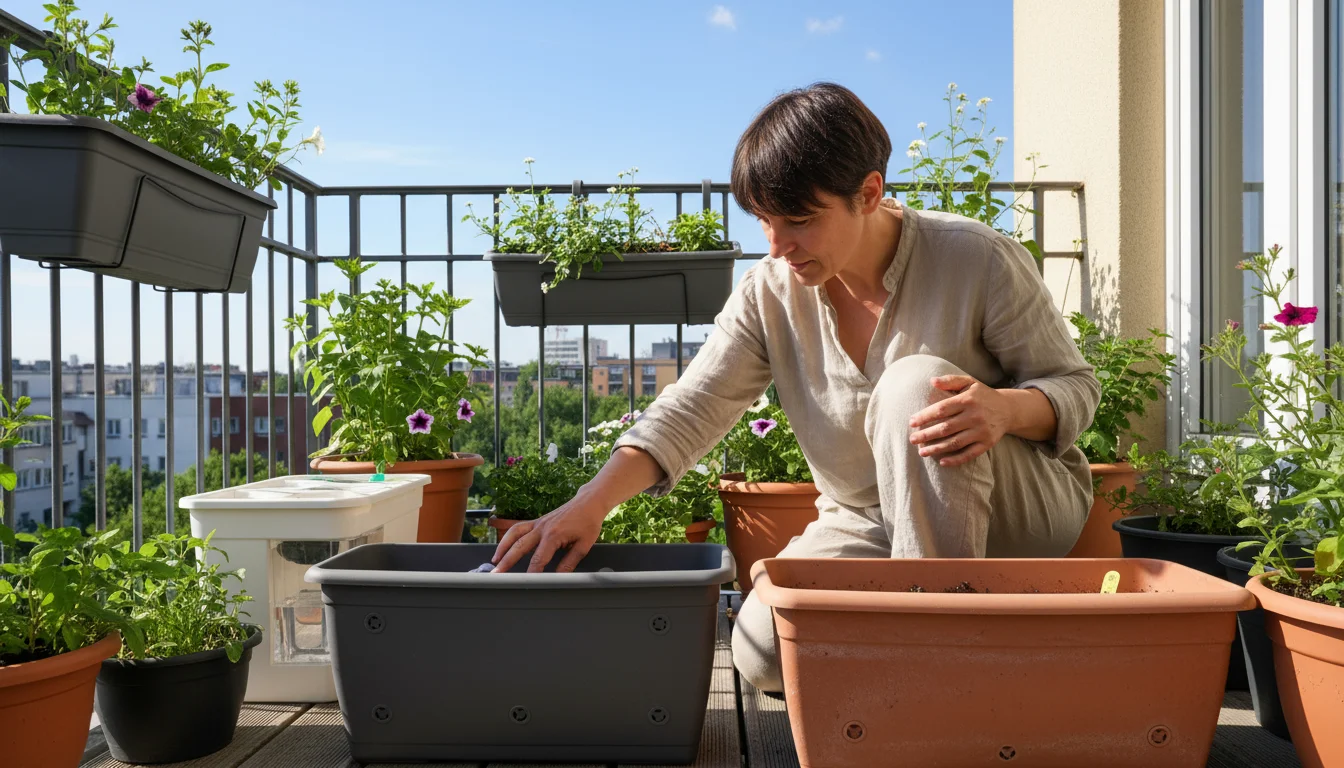
Choosing Your Window Boxes: Size, Material, and Drainage
Selecting the right window box is fundamental to the success of your edible pansies and violas. The container serves as your plants’ home, directly impacting their health and productivity.
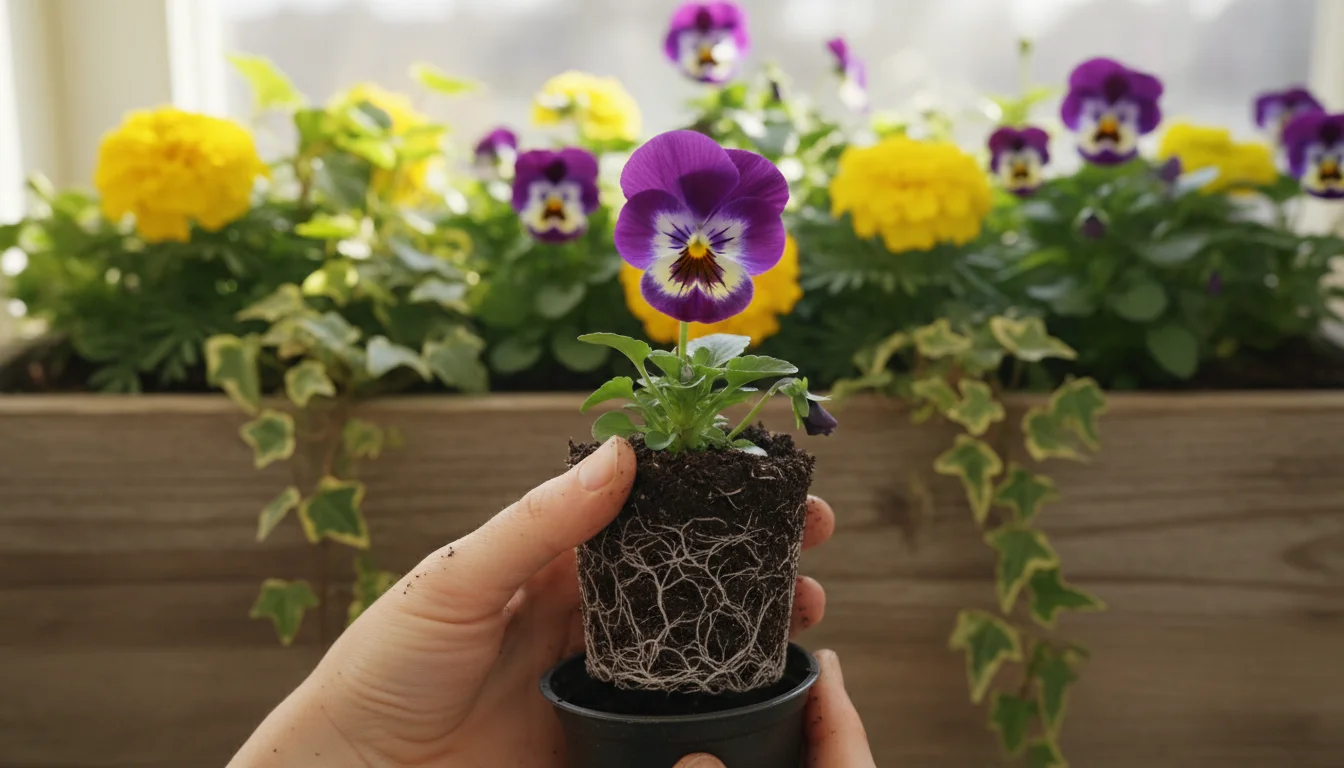
Size Matters for Root Health
For growing pansies in pots, depth is more critical than width. Pansies and violas develop a respectable root system, even though their top growth remains compact. Aim for window boxes that are at least 8 inches deep. Boxes that are 10-12 inches deep provide even better insulation for roots against temperature fluctuations and allow for a larger volume of soil, which retains moisture more consistently. A 24-inch long box can hold 4-6 plants comfortably, while a 36-inch box accommodates 6-8 plants. Overcrowding inhibits air circulation and nutrient uptake, leading to weaker plants and fewer blooms.

Material Options: Aesthetics and Functionality
Window boxes come in various materials, each with its own advantages:
- Plastic: Lightweight, affordable, and excellent at retaining moisture, reducing your watering frequency. Many plastic options now mimic the look of more expensive materials. They are durable and easy to clean.
- Fiberglass: Offers the aesthetic appeal of terracotta or stone without the weight. Fiberglass boxes are durable, weather-resistant, and provide good insulation. They tend to be more expensive but offer longevity.
- Wood: Provides a rustic, natural look. Cedar or redwood are good choices as they resist rot. If you choose wood, line the interior with a heavy-duty plastic liner (punch holes in the bottom of the liner) to prolong the box’s life and prevent soil from drying out too quickly. Avoid pressure-treated wood, as the chemicals can leach into the soil and affect edible plants.
- Metal: Often sleek and modern. Ensure metal boxes have a rust-resistant coating and consider their heat-retention properties. Dark metal can heat up quickly in direct sun, potentially stressing roots. A lighter color or lining might be beneficial.
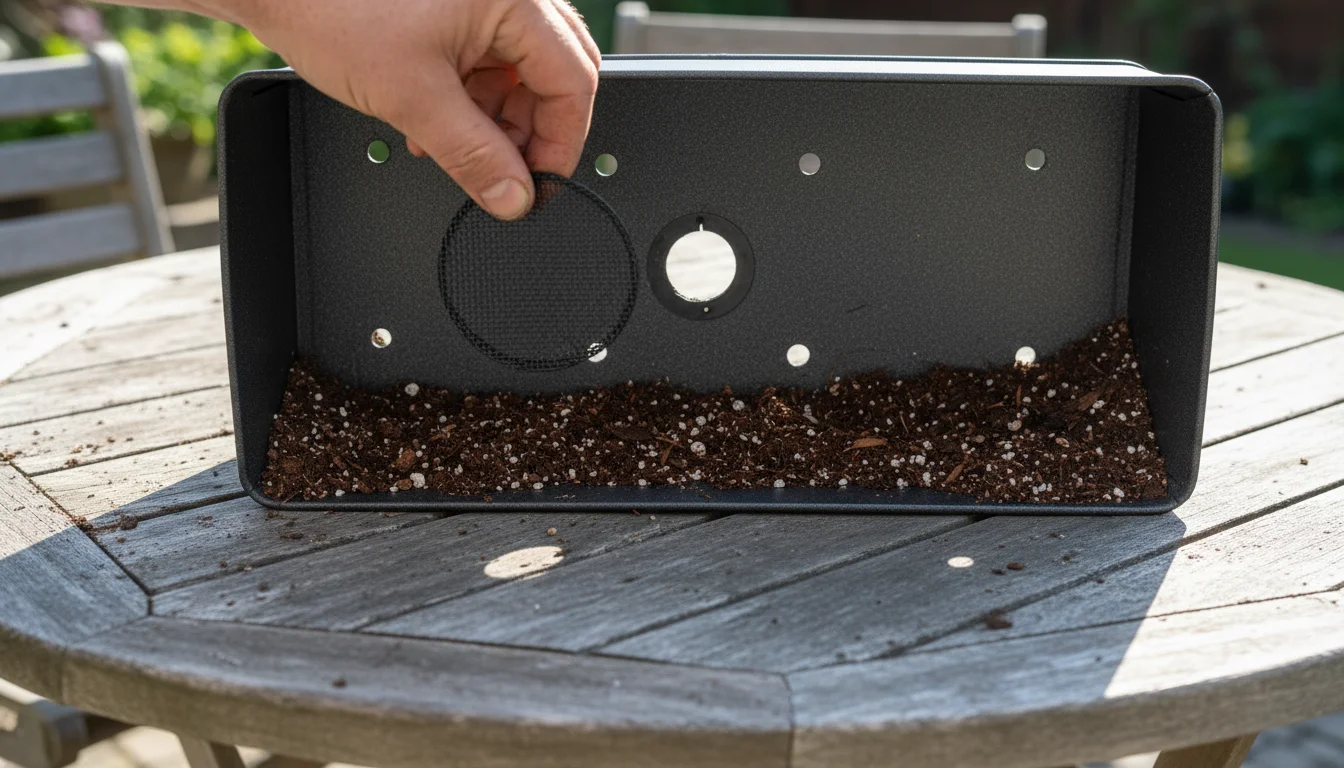
Non-Negotiable: Excellent Drainage
Regardless of material, proper drainage is absolutely essential. Pansies and violas hate “wet feet.” Stagnant water causes root rot, a common killer of container plants.
- Ensure your window box has drainage holes at the bottom. Multiple holes, roughly 0.5 to 1 inch in diameter, work best.
- If holes are too large, cover them with a piece of screening, coffee filter, or a broken terracotta shard to prevent soil from washing out while allowing water to escape. Avoid using gravel or packing peanuts at the bottom, as this actually impedes drainage and reduces valuable soil volume for roots.
- Consider a tray or saucer underneath your window box to catch excess water and protect surfaces below. Empty this tray promptly after watering to prevent waterlogging.
By carefully selecting your window box, you provide your edible flowers with the optimal environment to thrive, ensuring a bountiful and beautiful fall harvest.
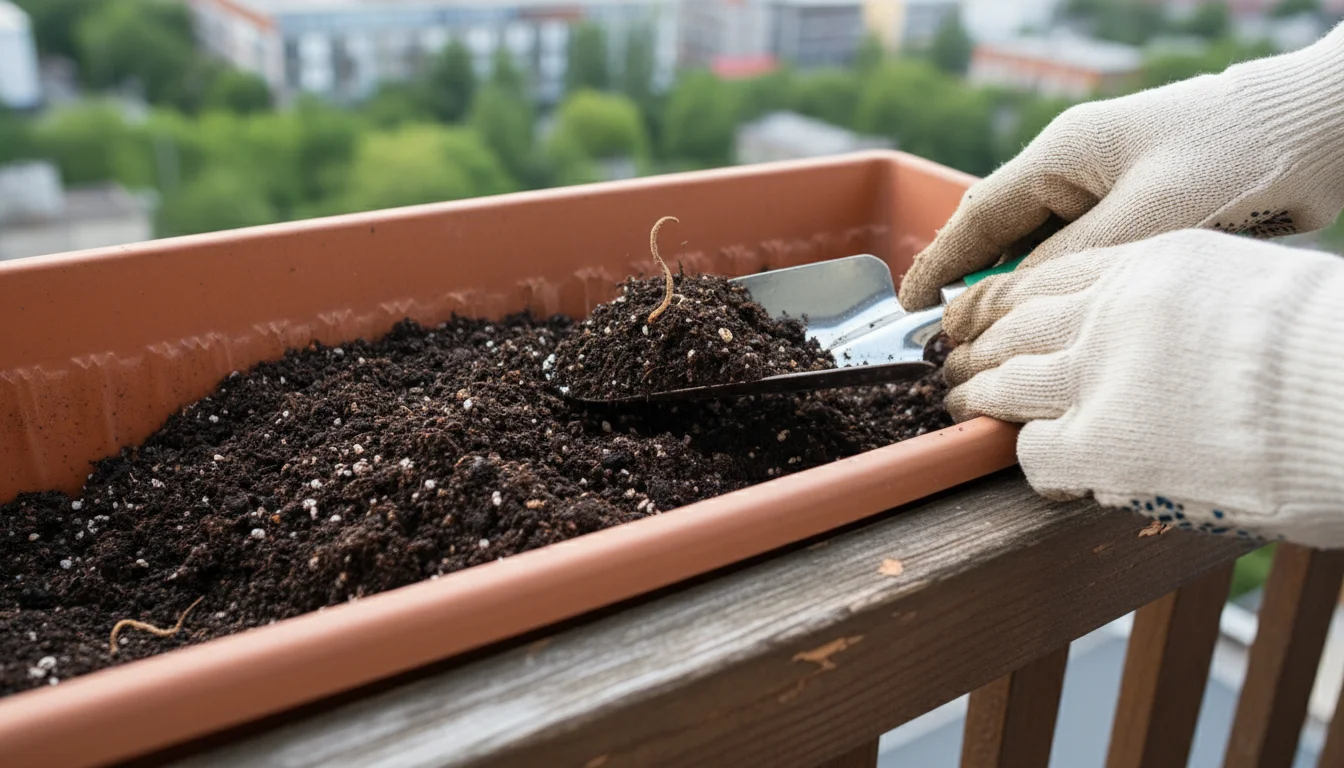
The Right Foundation: Potting Mix for Edible Flowers
The soil you use in your window boxes dictates the health and vigor of your edible pansies and violas. Unlike garden soil, potting mix is specifically formulated for containers, providing the ideal balance of drainage, aeration, and nutrient retention necessary for growing pansies in pots.
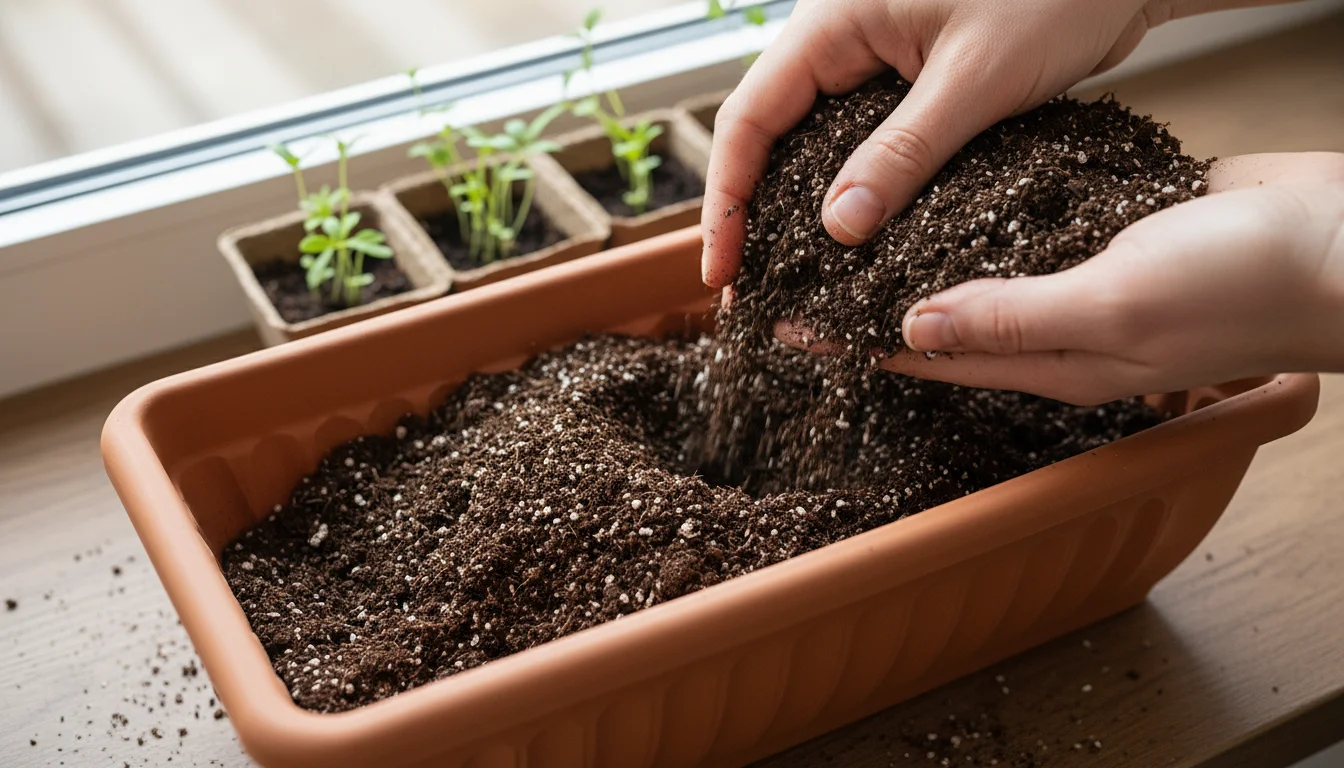
Why Container-Specific Potting Mix is Key
Garden soil compacts heavily in containers, preventing roots from accessing air and nutrients. It often harbors weed seeds and pathogens. A good quality potting mix, however, is light, fluffy, and sterile. It promotes healthy root development, allows for proper water flow, and supports vigorous growth for edible flowers.

Components of an Ideal Potting Mix
Look for a high-quality, peat-free organic potting mix. Peat-free options are more environmentally conscious, as peat harvesting contributes to habitat destruction and climate change. A good mix typically includes:
- Composted Materials: Provides essential nutrients and beneficial microbes. This can include composted bark, leaf mold, or mushroom compost.
- Coco Coir: A sustainable alternative to peat moss, coco coir retains moisture effectively while also allowing for good drainage. It is pH neutral and provides excellent aeration.
- Perlite or Vermiculite: These lightweight, inert materials improve drainage and aeration, preventing compaction. Perlite helps with drainage, while vermiculite holds more moisture and nutrients.
- Worm Castings: Often included in organic mixes, worm castings are a fantastic source of slow-release nutrients and beneficial soil biology.
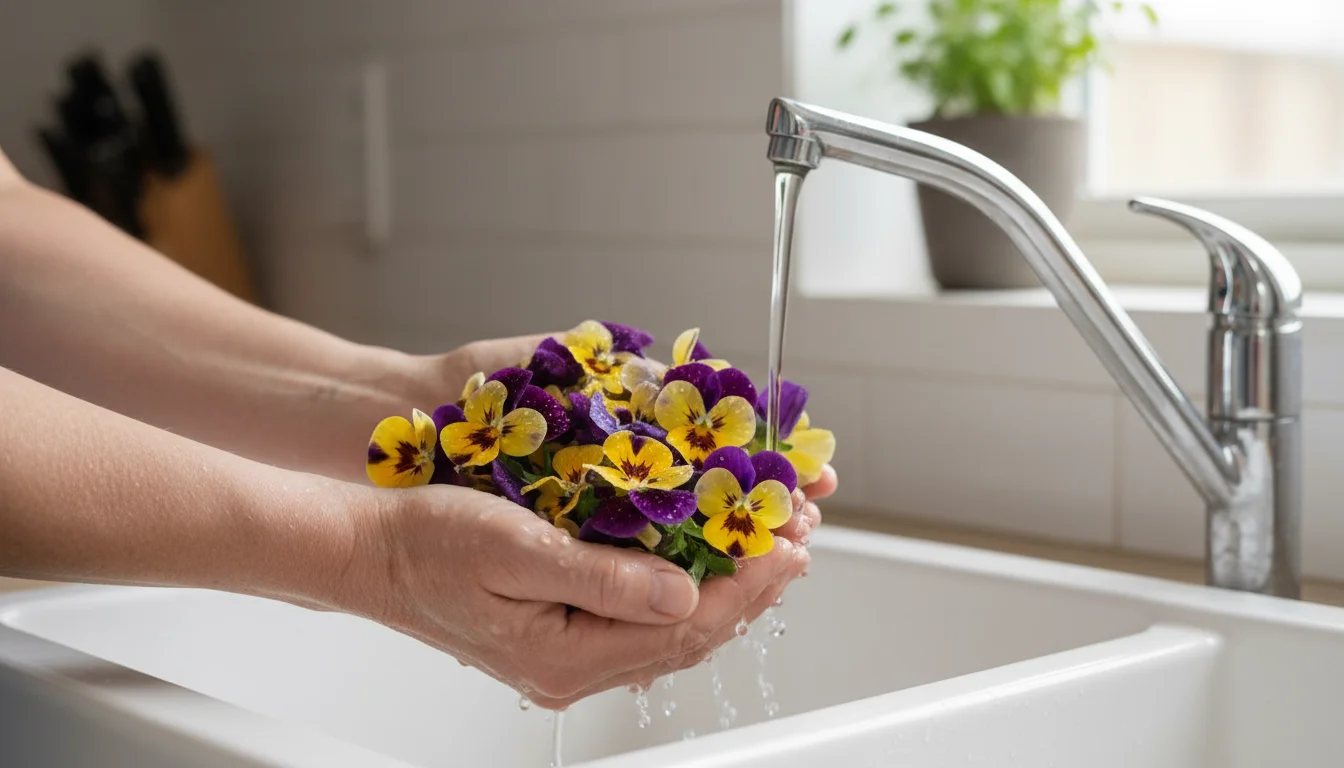
Ensuring Food Safety
Since you will eat these flowers, choose a potting mix labeled “organic” or “suitable for edibles.” This ensures the ingredients meet organic standards and are free from synthetic fertilizers or pesticides that are not safe for consumption.

Reusing and Refreshing Potting Mix
You can often reuse potting mix from previous seasons, but it requires refreshing. Each growing season, plants deplete nutrients and alter the soil structure.
- Empty the old potting mix into a wheelbarrow or large bin. Remove any large root balls or debris.
- Add fresh organic compost (about 25-30% of the total volume). Compost replenishes nutrients and improves soil structure.
- Incorporate a slow-release organic granular fertilizer or a handful of worm castings. This provides a steady supply of nutrients for your new edible flowers.
- If the mix feels too dense, add more perlite or coco coir to improve aeration.
Refreshing your potting mix saves money and reduces waste, aligning with environmentally conscious gardening practices. Starting with a robust and healthy potting mix sets your pansies and violas up for a successful and abundant fall harvest.
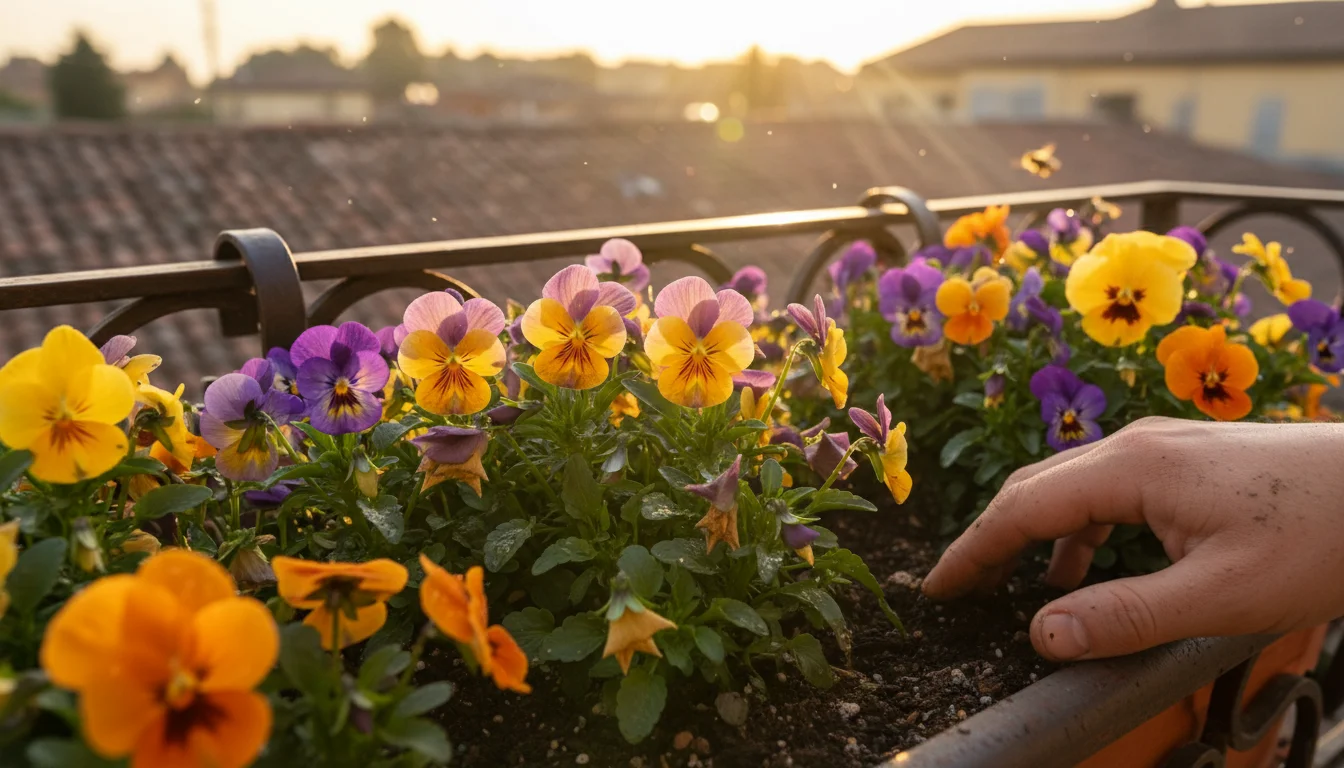
Sun, Water, and Nutrients: The Care Rhythm for Pansies and Violas
Establishing a consistent care rhythm for sun exposure, watering, and feeding ensures your edible pansies and violas thrive in their window boxes, delivering a continuous supply of beautiful blooms for your table.

The Right Light: Sun Exposure
Pansies and violas perform best in full sun to partial shade during the fall.
- Full Sun: This means at least 6 hours of direct sunlight per day. In cooler fall temperatures, full sun encourages robust flowering and compact growth. Place your window boxes where they receive ample morning sun, as this helps dry foliage and reduces disease risk.
- Partial Shade: If your window boxes face west or south and experience intense afternoon sun, particularly in warmer early fall regions, a spot with 4-6 hours of morning sun and afternoon shade is ideal. This protects the plants from heat stress, which can cause them to stretch and reduce blooming.
Observe how sunlight shifts as fall progresses. Lower sun angles mean your plants might receive less direct light than they did in summer. Adjust your window box placement if necessary to maximize light exposure.
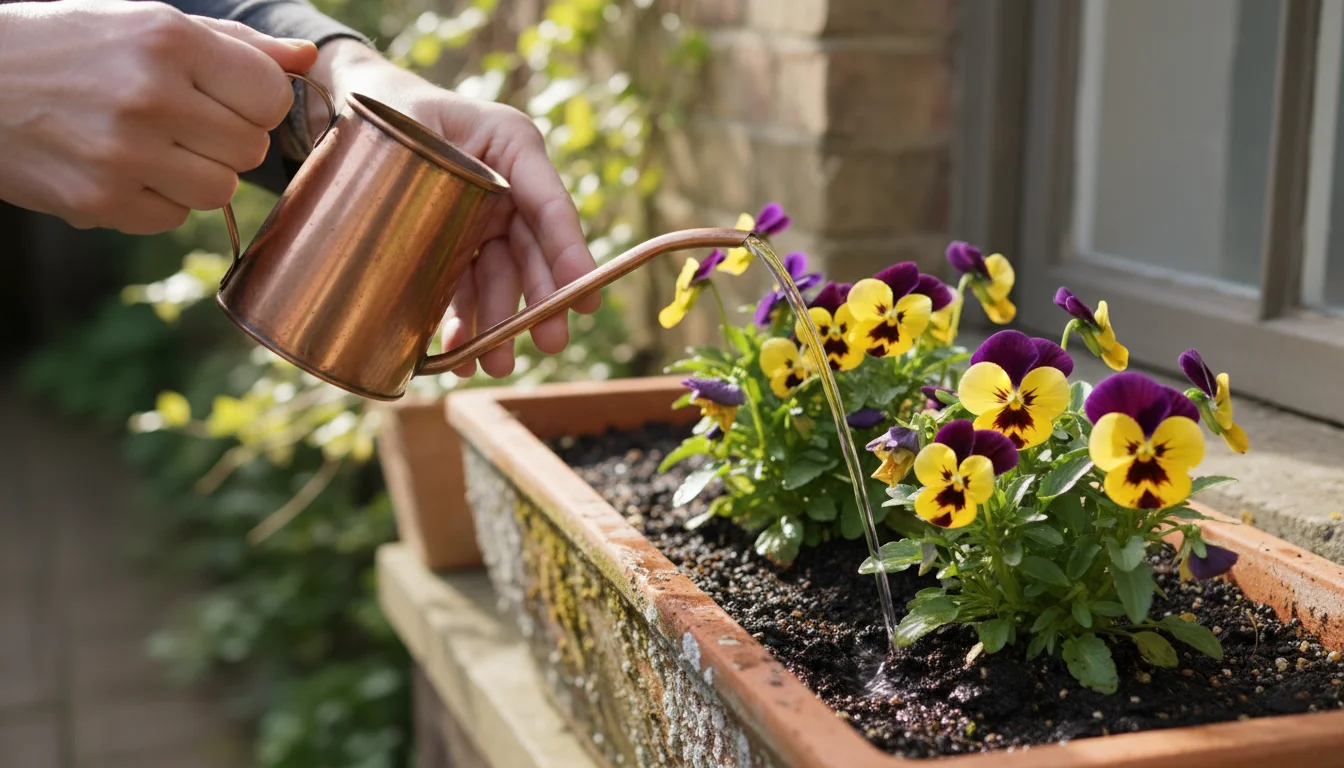
The Art of Watering: Deep and Consistent
Container plants dry out faster than garden beds, so consistent watering is crucial for growing pansies in pots.
- Check Daily: Feel the top inch of potting mix. If it feels dry, it is time to water. Do not wait until plants wilt dramatically; that signals significant stress.
- Water Thoroughly: Water until you see moisture draining from the bottom of the window box. This ensures water reaches all the roots. Surface watering encourages shallow root systems.
- Avoid Overhead Watering: Water the soil directly to keep foliage dry, especially in the evening. Wet leaves can promote fungal diseases, particularly in cool, damp fall conditions.
- Factor in Weather: On windy days, containers dry out much faster. During prolonged dry spells, you may need to water daily. If you receive consistent fall rain, reduce or skip watering.
Consider self-watering window boxes, which have a reservoir that wicks water up to the soil. These systems reduce watering frequency and ensure consistent moisture, a boon for busy gardeners.

Nourishing Your Blooms: Organic Feeding Cadence
Even with a nutrient-rich potting mix, your flowering pansies and violas benefit from supplemental feeding to support continuous blooming.
- Start with a Boost: When planting, incorporate a slow-release organic granular fertilizer directly into your potting mix. This provides a steady release of nutrients for several weeks.
- Liquid Feed Regularly: Every 2-4 weeks, apply a balanced liquid organic fertilizer diluted to half strength. Look for formulations with slightly higher phosphorus (the middle number in the N-P-K ratio) to encourage flowering. Examples include fish emulsion, kelp meal, or a balanced organic flower food.
- Observe Your Plants: Yellowing lower leaves can indicate a nitrogen deficiency, while a lack of new blooms might signal a phosphorus need. Adjust feeding based on your plants’ appearance and performance.
A consistent sun, water, and nutrient rhythm provides your edible pansies and violas with everything they need to flourish, ensuring a beautiful display and a continuous harvest of edible flowers throughout the fall.
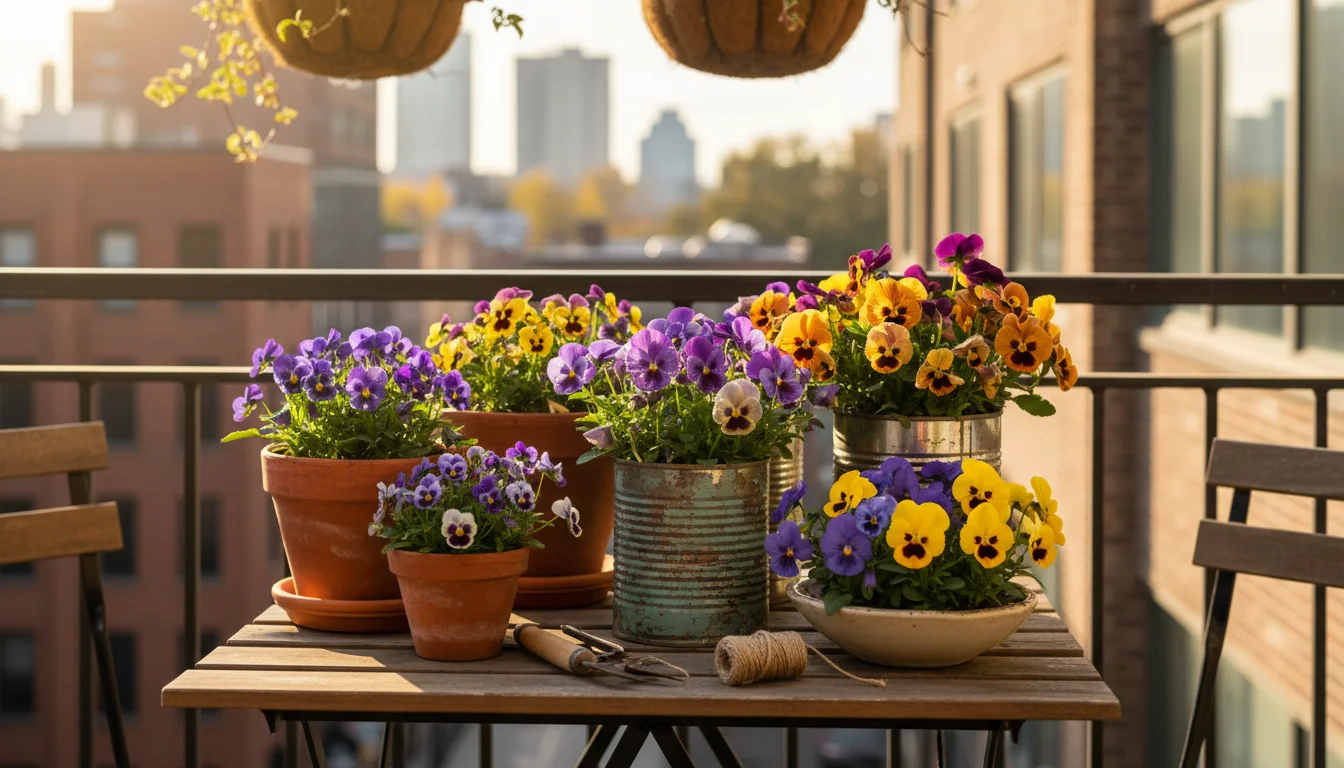
Top Edible Pansy and Viola Varieties for Fall
Choosing the right varieties is key to a successful fall container gardening experience with edible pansies and violas. While all pansies and violas are generally considered edible, some varieties offer superior flavor, appearance, or cold hardiness, making them ideal for your window boxes. When looking for what flowers can you eat that grow in fall, these varieties stand out.
Here is a selection of excellent choices, perfect for growing pansies in pots:
| Variety Name | Flower Size | Color Range | Flavor Profile | Special Characteristics for Fall |
|---|---|---|---|---|
| Viola ‘Johnny Jump Up’ | Small (0.5-1 inch) | Purple, yellow, white with contrasting “faces” | Slightly sweet, mild wintergreen or peppery notes | Extremely cold hardy, self-seeds readily, prolific bloomer. Iconic edible flower. |
| Viola ‘Sorbet Series’ | Medium (1-1.5 inches) | Wide range: blues, yellows, oranges, bicolors, often with whiskers | Mild, slightly sweet, fresh vegetable note | Excellent cold tolerance, compact growth, high flower count, good for mass planting. |
| Viola ‘Penny Series’ | Medium (1-1.5 inches) | Bright solid colors and bicolors: yellow, orange, violet, white | Very mild, subtle sweetness | Remarkable vigor and cold hardiness, bred for continuous bloom, performs well in containers. |
| Pansy ‘Delta Series’ | Large (2-3 inches) | Extensive range: blues, reds, yellows, whites, often with dark blotches or faces | Mild, faintly grassy or fresh lettuce taste | Known for consistent bloom through cold weather, strong stems, good for larger window boxes. |
| Pansy ‘Matrix Series’ | Large (2-3 inches) | Bold, clear colors and contrasting faces, including unique shades like ‘Matrix Morpheus’ (purple-orange) | Similar to ‘Delta’, fresh and mild | Exceptional cold performance, uniform plant habit, excellent for vibrant fall displays. |
| Viola ‘Miniature’ Mixes | Very Small (0.5 inch) | Diverse mix of purples, yellows, blues, creams | Delicate, subtle sweetness, sometimes a light minty hint | Great for intricate garnishes, often more resilient to light frost than larger pansies, very charming. |
When you purchase plants, look for healthy, compact specimens with plenty of buds. Avoid leggy plants or those with yellowing leaves or signs of disease. For a longer season, consider starting from seed. Starting pansies and violas from seed in late summer allows them to establish strong root systems before the cold sets in, leading to a more robust fall and potentially even early spring display.
Remember that while these varieties are specifically recommended for their qualities as edible flowers, all varieties of *Viola tricolor* (pansies) and *Viola cornuta* (horned violas) are generally considered safe to eat. Always double-check with your plant nursery or seed supplier to confirm that no harmful systemic pesticides were used on edible plants. This ensures your beautiful blooms are safe for your consumption.
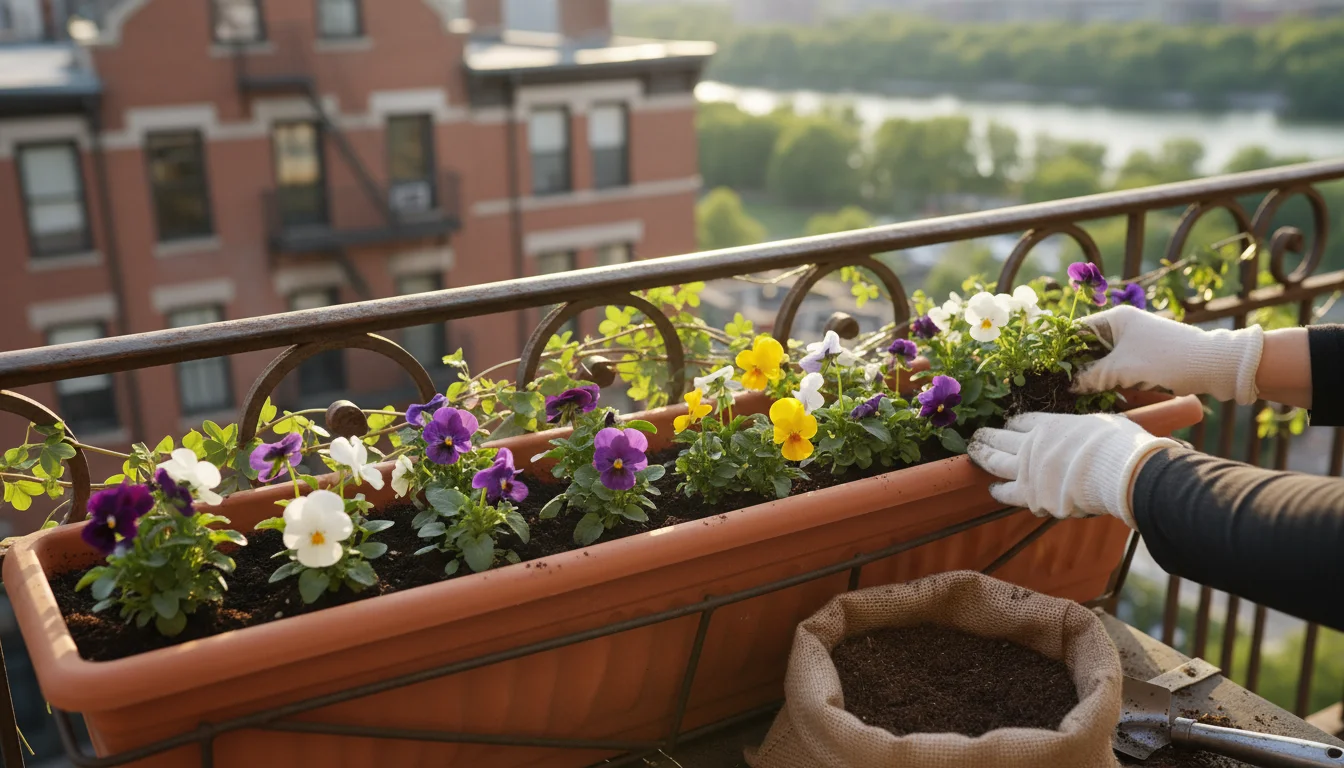
Planting for Success: Spacing and Establishment
Proper planting techniques ensure your edible pansies and violas establish quickly and grow vigorously in their window boxes. Getting the spacing right is particularly important for air circulation and nutrient access in small containers.
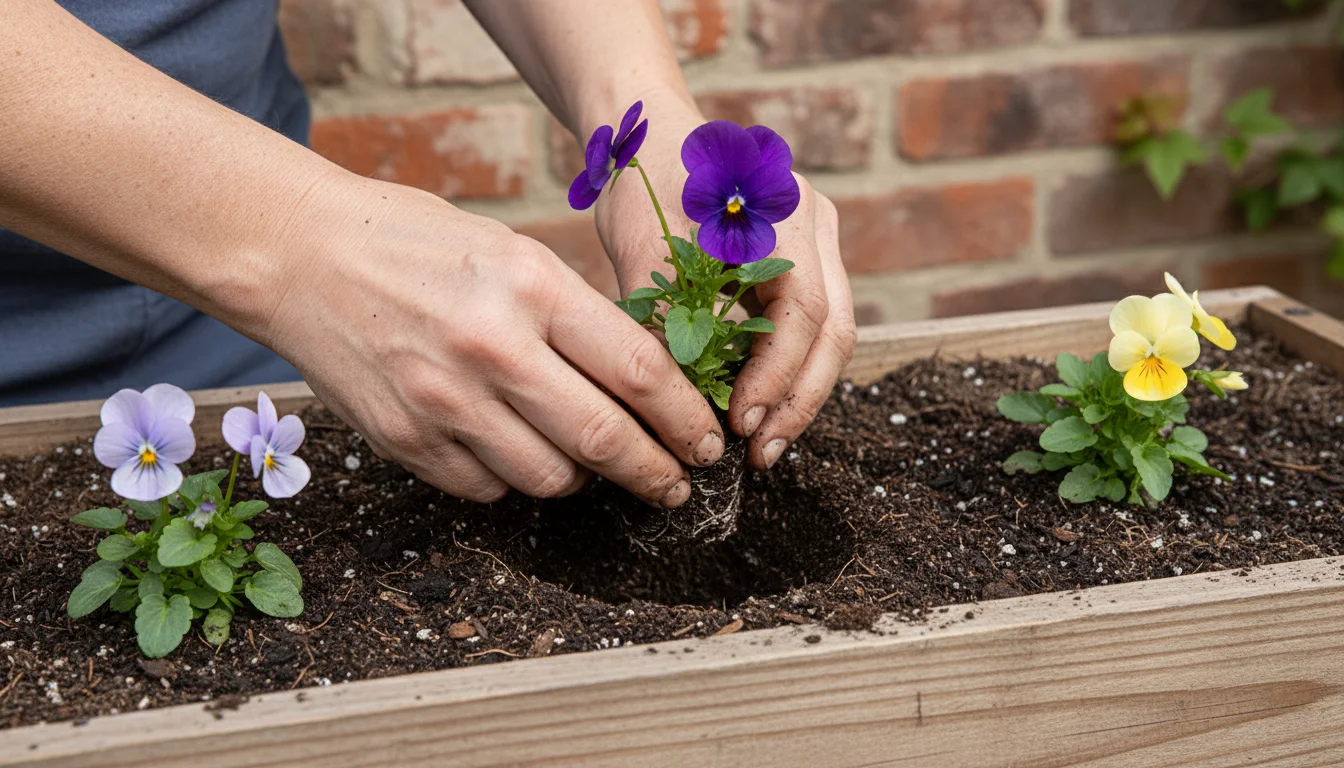
Step-by-Step Planting Guide
Follow these steps to successfully plant your edible flowers:
- Prepare Your Window Box: Fill your chosen window box with your high-quality, peat-free organic potting mix, leaving about 1 inch of space from the rim. Gently moisten the soil.
- Remove Plants from Nursery Pots: Carefully squeeze the sides of the nursery pot and gently slide the plant out. If roots are circling the bottom, gently tease them apart with your fingers. This encourages them to grow outwards into the new potting mix.
- Position Plants for Optimal Spacing: Arrange your pansies and violas in the window box before you start digging holes. For most varieties, space plants 4-6 inches apart. This spacing allows adequate air circulation to prevent fungal issues and gives each plant enough room to spread its roots and produce flowers without competing too fiercely for resources. For example, a 24-inch window box can comfortably hold 4-5 pansies, while a 36-inch box can hold 6-8.
- Plant at the Correct Depth: Dig a hole for each plant, ensuring the top of the root ball is level with the surrounding potting mix. Do not bury the stem or expose the roots.
- Backfill and Gently Firm: Once positioned, backfill with potting mix, gently firming the soil around the base of each plant to remove air pockets. Do not compact the soil too tightly; it should remain loose enough for water and air penetration.
- Water Thoroughly After Planting: Immediately after planting, give your window box a deep watering until water drains from the bottom. This settles the soil around the roots and helps reduce transplant shock.
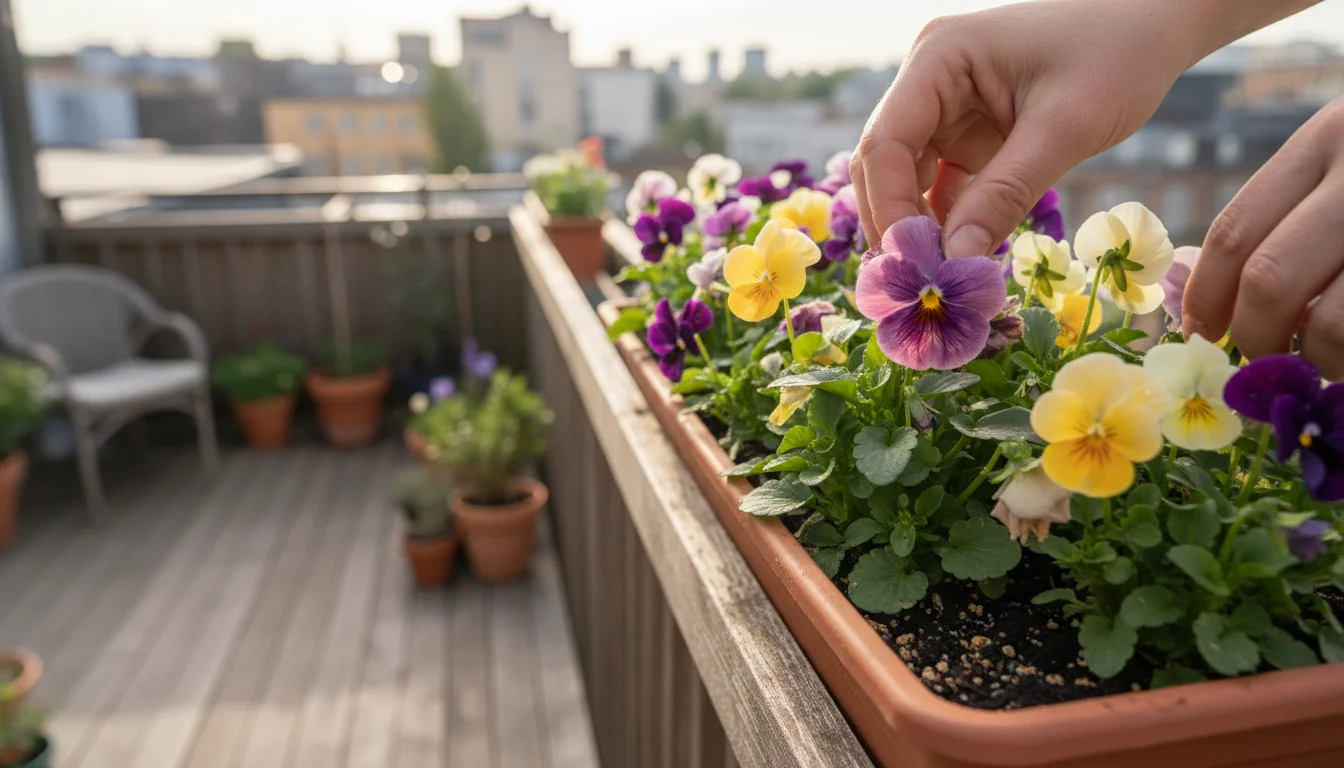
Initial Establishment Care
The first few weeks after planting are crucial for establishment:
- Consistent Moisture: Keep the soil consistently moist, but not soggy. Check the potting mix daily, especially during sunny or windy periods.
- Monitor for Stress: Watch for wilting, yellowing leaves, or stunted growth. These can be signs of transplant shock, improper watering, or nutrient deficiency.
- Pinch Back Faded Blooms: Begin deadheading as soon as flowers start to fade. This redirects the plant’s energy from seed production to producing more blooms, ensuring a continuous supply of edible flowers.
By providing proper spacing and attentive care during the establishment phase, you set the stage for a thriving, beautiful, and delicious display of edible pansies and violas throughout the fall.

Keeping Pests at Bay: Organic Solutions for Edible Flowers
Even in small-space container gardening, pests can sometimes find your edible pansies and violas. Since you plan to eat these beautiful flowers, opting for organic and least-toxic pest management strategies is paramount. Integrated Pest Management (IPM) focuses on prevention, monitoring, and targeted, eco-friendly solutions.
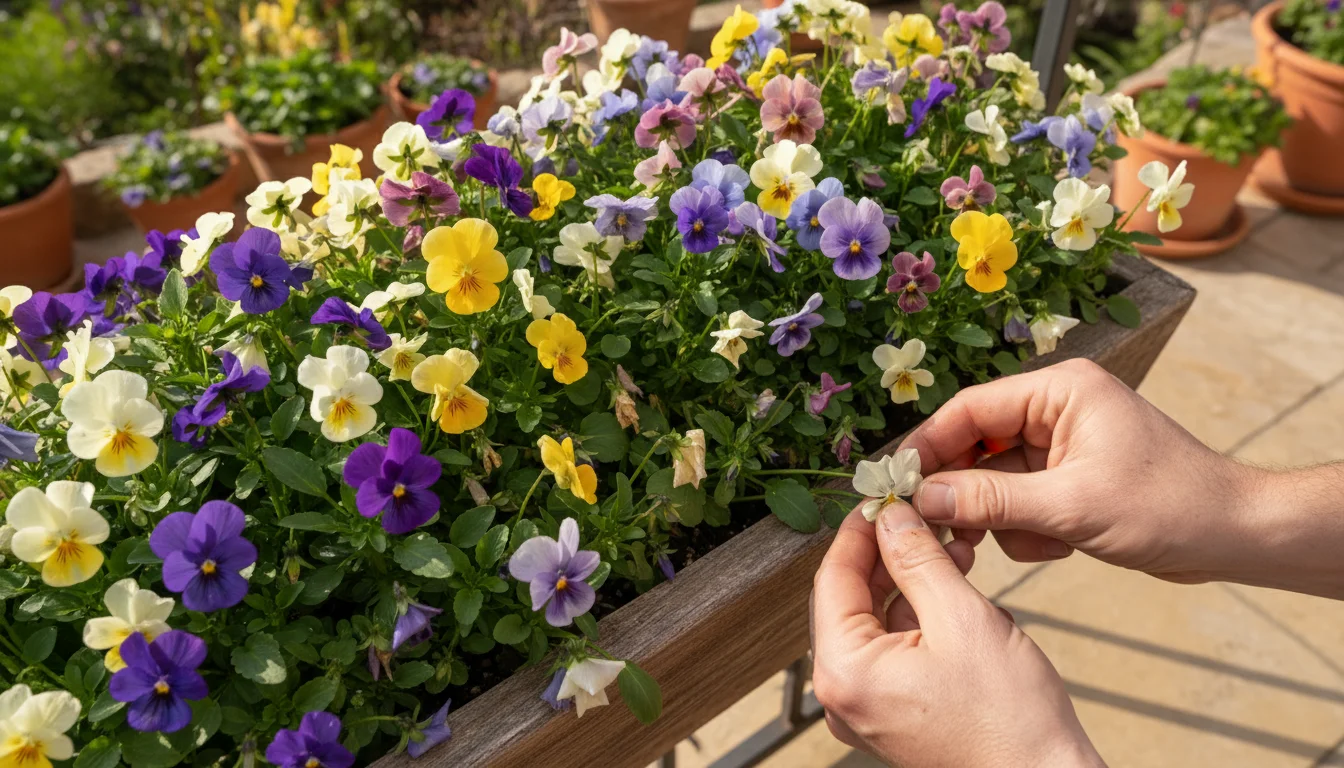
Prevention: Your First Line of Defense
Proactive measures significantly reduce the likelihood of pest outbreaks.
- Start with Healthy Plants: Purchase strong, disease-free seedlings. Healthy plants are naturally more resistant to pest damage.
- Good Air Circulation: Space your plants properly (as discussed in the planting section) to allow air to flow freely around them. This deters fungal diseases and makes it harder for pests to establish colonies.
- Use Clean Potting Mix: Always use fresh, sterile potting mix or thoroughly refresh reused mix to avoid introducing pest eggs or larvae.
- Sanitation: Remove any fallen leaves, spent flowers, or plant debris from your window boxes. This eliminates hiding places for pests and reduces sources of disease.
- Attract Beneficial Insects: While window boxes may not be a large habitat, nearby pollinator-friendly plants in your garden can attract beneficial insects like ladybugs and lacewings, which prey on common pests like aphids.
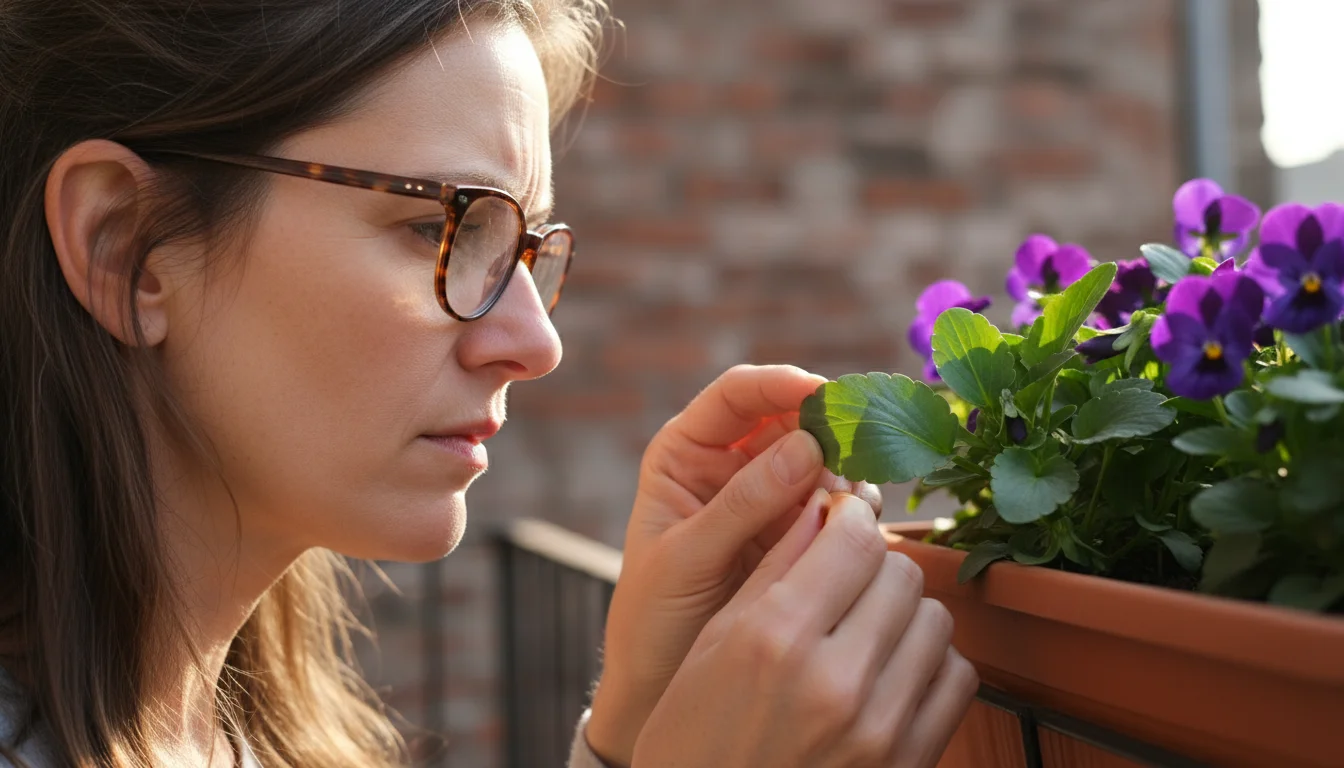
Monitoring: Catch Problems Early
Regularly inspecting your pansies and violas allows you to identify pest issues before they become severe.
- Daily Check: Take a few moments each day to look closely at your plants. Examine both the tops and undersides of leaves, stems, and flower buds.
- Look for Clues: Watch for sticky residue (honeydew), tiny holes in leaves, distorted growth, or the presence of actual insects.
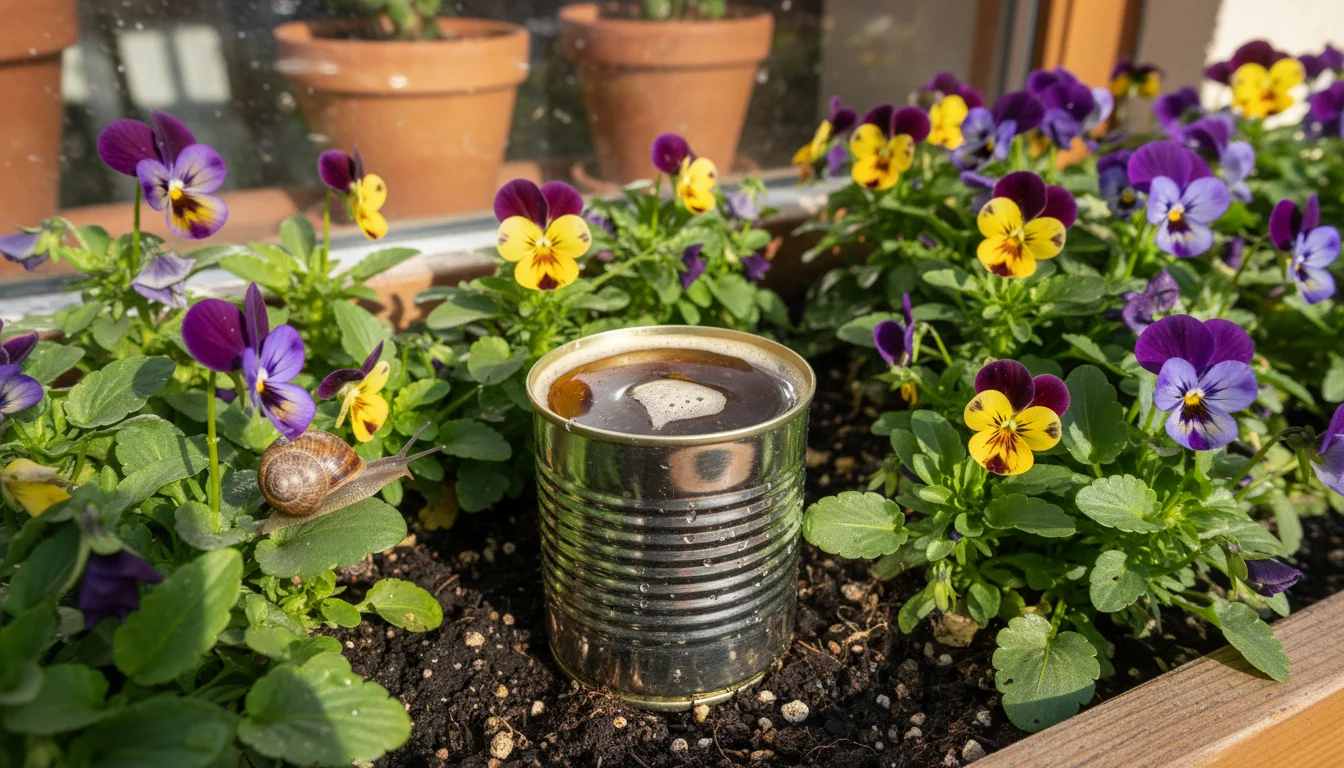
Common Pests and Organic Solutions
Should you spot unwelcome visitors, here are some common culprits and safe, organic ways to manage them:
- Aphids: These small, soft-bodied insects cluster on new growth and suck plant sap.
- Hand-picking/Water Blast: For small infestations, simply pick them off or blast them gently with a strong stream of water from your hose (do this in the morning so foliage dries quickly).
- Insecticidal Soap: For larger outbreaks, spray with an insecticidal soap solution (ensure it is approved for organic use and follow label directions carefully). Soap suffocates pests without leaving harmful residues.
- Slugs and Snails: They chew irregular holes in leaves and leave silvery trails.
- Hand-picking: Go out in the early morning or evening with a flashlight and hand-pick them off, dropping them into a bucket of soapy water.
- Beer Traps: Bury shallow dishes (like tuna cans) filled with beer so the rim is level with the soil. Slugs are attracted to the yeast, fall in, and drown.
- Copper Tape: Apply copper tape around the rim of your window box. Slugs and snails receive a mild electric shock when they try to cross it.
- Spider Mites: Tiny pests that cause stippling on leaves and fine webbing. They thrive in dry, hot conditions.
- Increase Humidity: Misting plants regularly can deter them, though avoid late-day misting which can encourage fungal issues.
- Insecticidal Soap/Neem Oil: Apply insecticidal soap or a diluted neem oil solution to thoroughly coat all plant surfaces, especially undersides of leaves. Neem oil acts as a repellent and growth disruptor.
Always test any new treatment on a small part of the plant first to ensure there is no adverse reaction. By employing these organic pest management strategies, you protect your edible flowers and ensure they remain safe and healthy for your fall harvest.
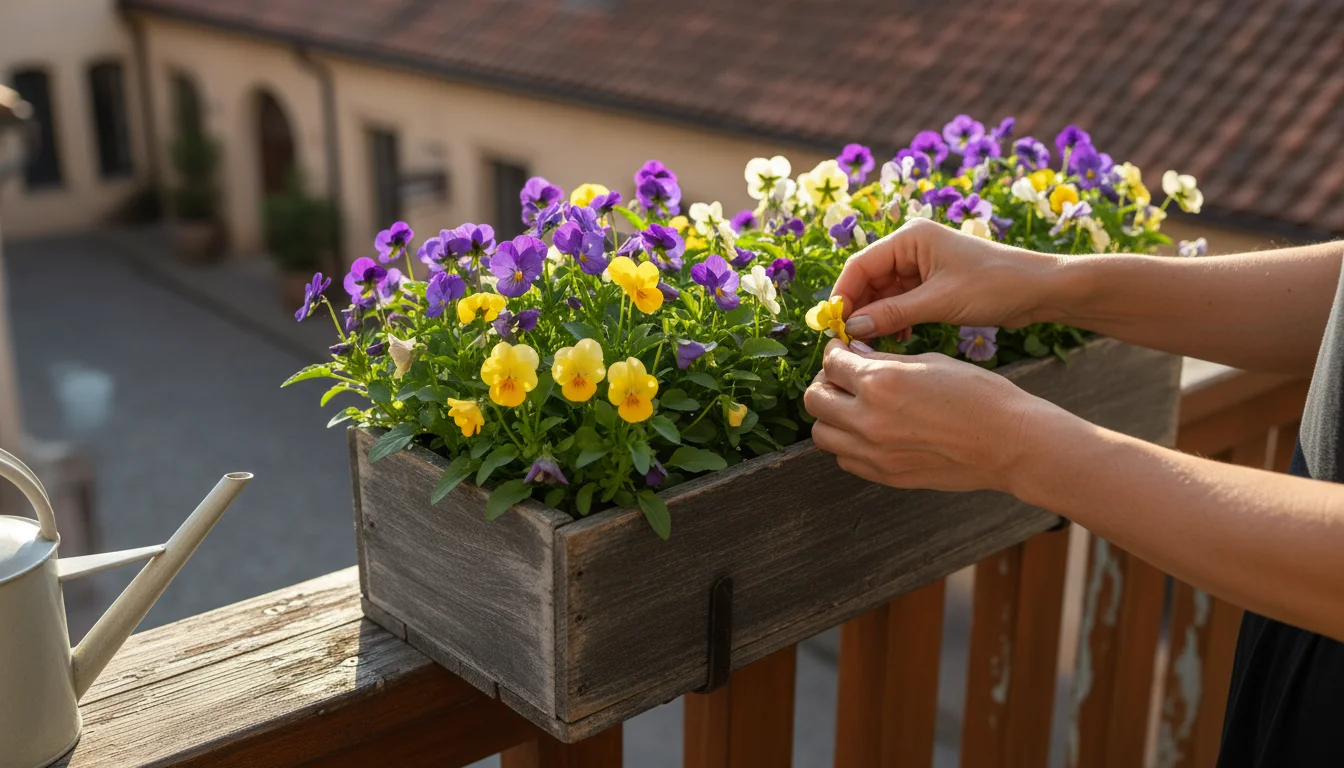
Harvesting Your Edible Blooms and Kitchen Uses
Harvesting your edible pansies and violas is a rewarding experience, transforming your window boxes into a living pantry. Knowing how and when to pick your blooms, along with creative ways to use them, maximizes your fall container gardening efforts.
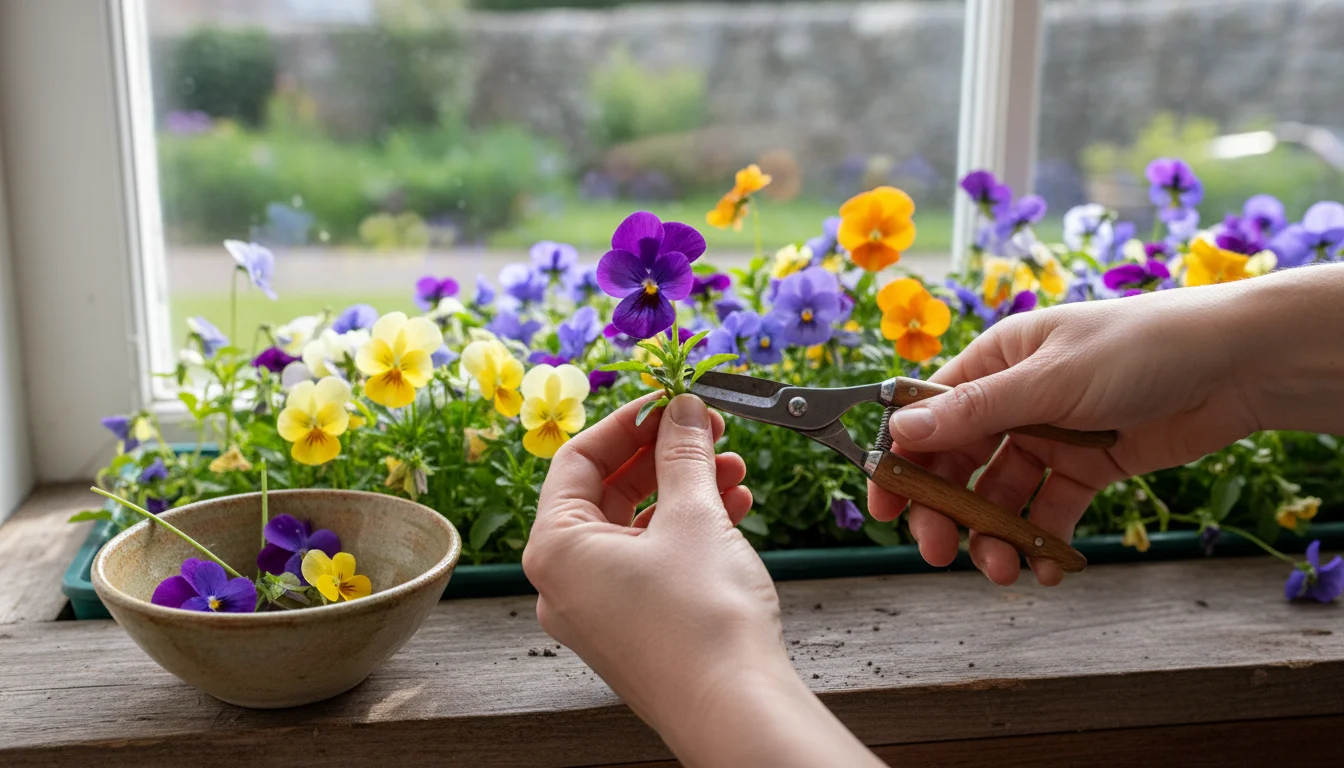
When and How to Harvest
Pansies and violas are “cut-and-come-again” plants, meaning they produce more flowers when you harvest them regularly.
- Timing is Key: Harvest flowers in the morning after the dew has dried, but before the heat of the day. At this time, they are most vibrant and have the best flavor.
- Choose Fresh Blooms: Select fully open flowers that look fresh and undamaged. Avoid faded, wilting, or bug-eaten blooms.
- Use Clean Snips: Pinch or snip the flower stem at the base, where it meets the main plant or a leaf node. Use clean scissors or garden snips to make a clean cut, which prevents damage to the plant and promotes new growth.
- Deadhead Regularly: Even if you do not plan to eat every flower, regularly remove spent or fading blooms (deadhead). This signals to the plant to produce more flowers instead of putting energy into seed production, ensuring a continuous supply of edible flowers.
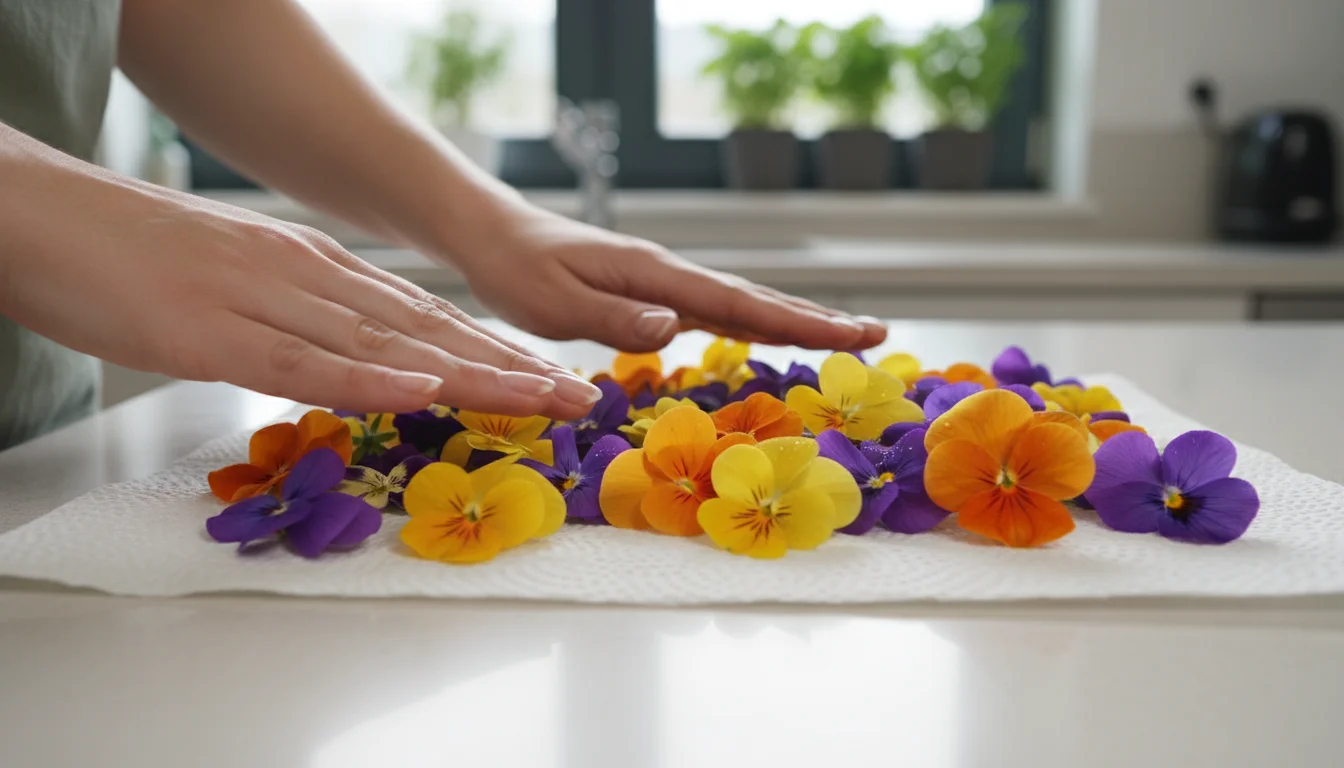
Preparing Your Harvest for the Kitchen
Once harvested, handle your edible blooms gently:
- Inspect for Pests: Carefully check each flower for any tiny insects or debris.
- Gentle Rinse: If necessary, gently rinse the flowers under cool, running water. Avoid soaking, which can damage their delicate petals.
- Pat Dry: Lay them on a clean paper towel or kitchen cloth and gently pat them dry. Excess moisture can make them wilt faster and degrade their texture.
- Immediate Use is Best: Edible flowers are most vibrant and flavorful when used fresh.
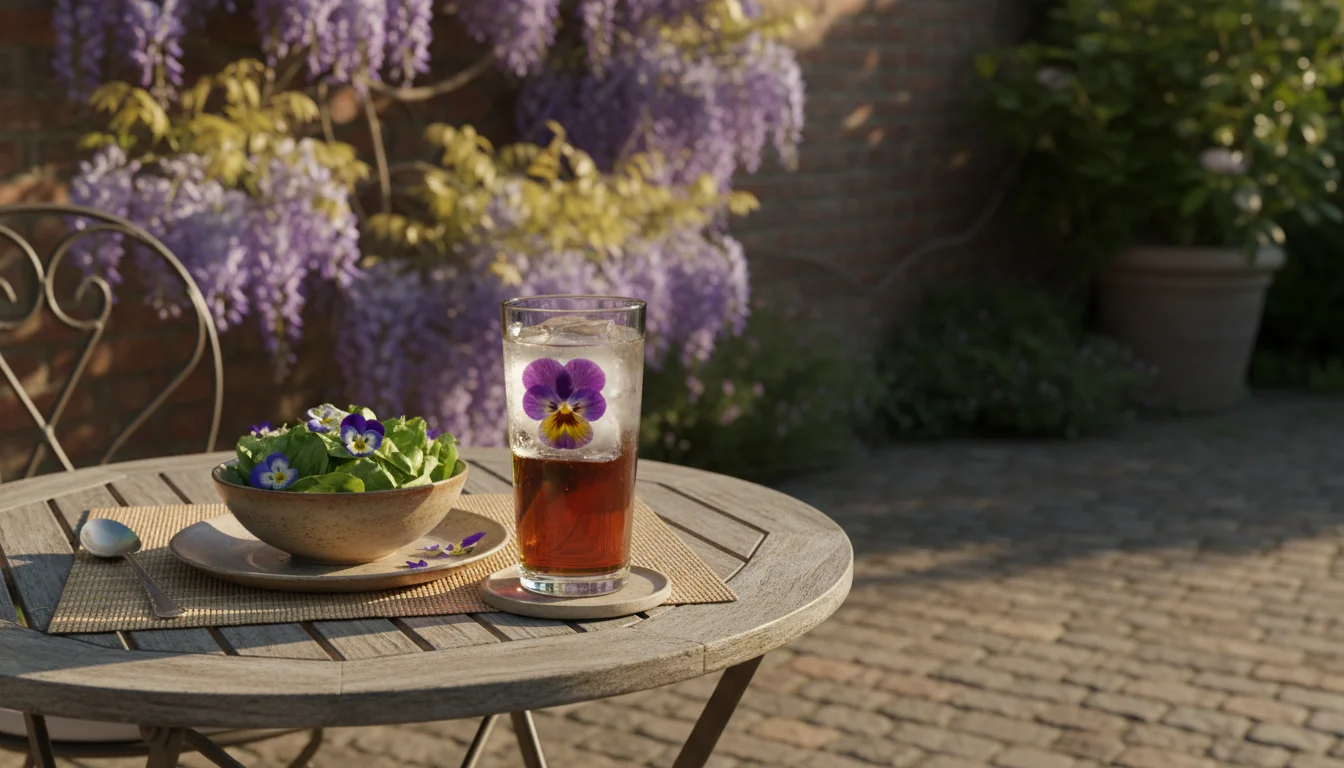
Creative Kitchen Uses for Edible Pansies and Violas
The culinary possibilities for these beautiful edible flowers are surprisingly varied.
- Salads: Sprinkle whole pansies or violas over green salads for a burst of color, texture, and a mild, fresh flavor. They complement both savory and fruit-based salads.
- Desserts:
- Cake and Cupcake Decor: Arrange them artfully on frosted cakes, cupcakes, or tarts.
- Candied Flowers: Lightly brush blooms with a whisked egg white, then dust with superfine sugar. Let them dry completely for a stunning, long-lasting garnish.
- Fruit Salads and Parfaits: Fold them into fruit salads or layer them into yogurt parfaits for an elegant touch.
- Beverages:
- Ice Cubes: Freeze individual flowers in ice cube trays with water. These floral ice cubes elevate drinks like lemonade, iced tea, or cocktails.
- Garnish: Float a few blooms on the surface of punches, cocktails, or sparkling water.
- Savory Dishes:
- Garnish for Soups and Appetizers: Use them to brighten creamy soups, bruschetta, or cheese boards.
- Sandwiches and Spreads: Press small violas into cream cheese spreads or use them as a decorative element in open-faced sandwiches.
For a unique fall touch, consider pairing the mild peppery notes of violas with roasted root vegetables or a creamy squash soup. The delicate visual appeal makes any dish feel special. By harvesting regularly and exploring these culinary applications, you truly maximize the enjoyment of your fall edible flower garden.
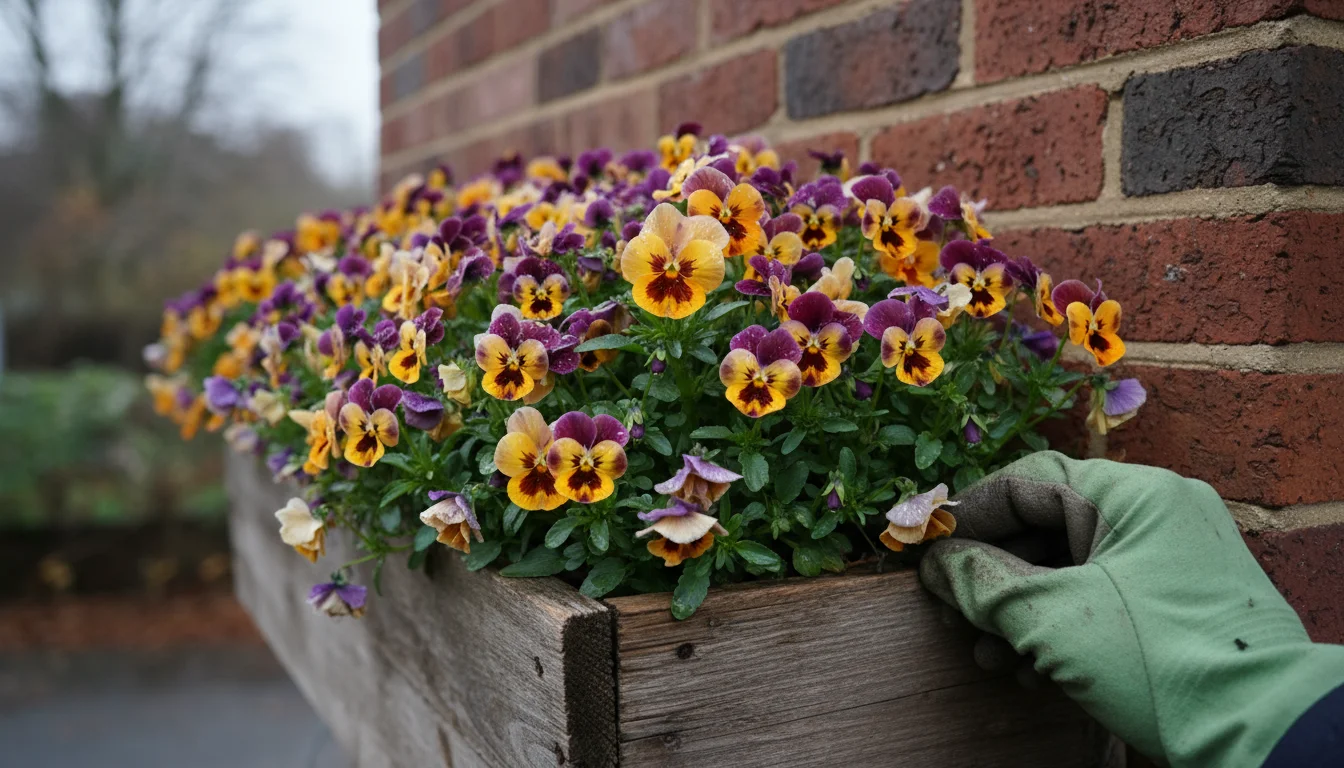
Seasonal Care: Extending Your Fall Display Through Cooler Weather
One of the great joys of growing edible pansies and violas is their cold hardiness, allowing you to enjoy your fall container gardening display long into the season and potentially beyond. With a few seasonal adjustments, you can significantly extend the life and bloom period of your window box flowers.
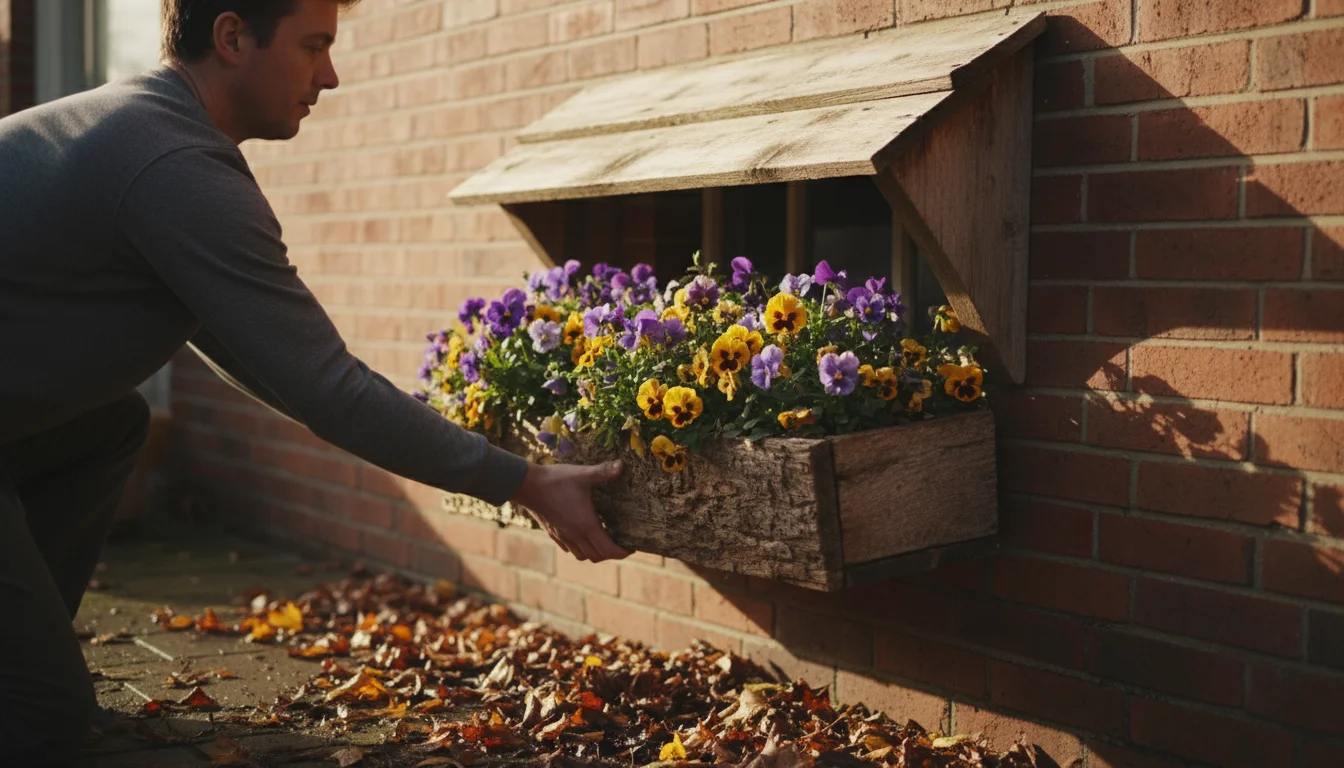
Preparing for Cooler Temperatures
As autumn progresses, the days shorten and temperatures drop. Your care routine should adapt:
- Reduce Watering Frequency: Plants use less water in cooler temperatures, and evaporation slows. Continue checking the soil moisture regularly, but expect to water less often than in early fall. Overwatering in cool, damp conditions can lead to root rot.
- Protect from Hard Frosts: While pansies and violas tolerate light frosts, prolonged freezes or hard frosts (temperatures consistently below 28°F or -2°C) can damage unprotected plants.
- Move Window Boxes: If your window boxes are portable, move them to a sheltered location, like against the warm wall of your house, under an overhang, or even temporarily indoors in an unheated garage or porch during severe cold snaps.
- Cover Plants: For fixed window boxes, cover your plants with a lightweight row cover, old sheet, or burlap before a hard freeze is expected. Remove the cover once temperatures rise above freezing.
- Mulch the Soil Surface: A thin layer of straw, shredded leaves, or wood chips on top of the potting mix provides insulation for the roots, protecting them from extreme temperature fluctuations. This also helps retain soil moisture.
- Fertilizer Adjustment: As growth slows with decreasing light and temperature, reduce or cease fertilization. Excessive feeding during dormancy or slow growth can lead to nutrient buildup and root burn. Resume light feeding in early spring if plants show new growth.
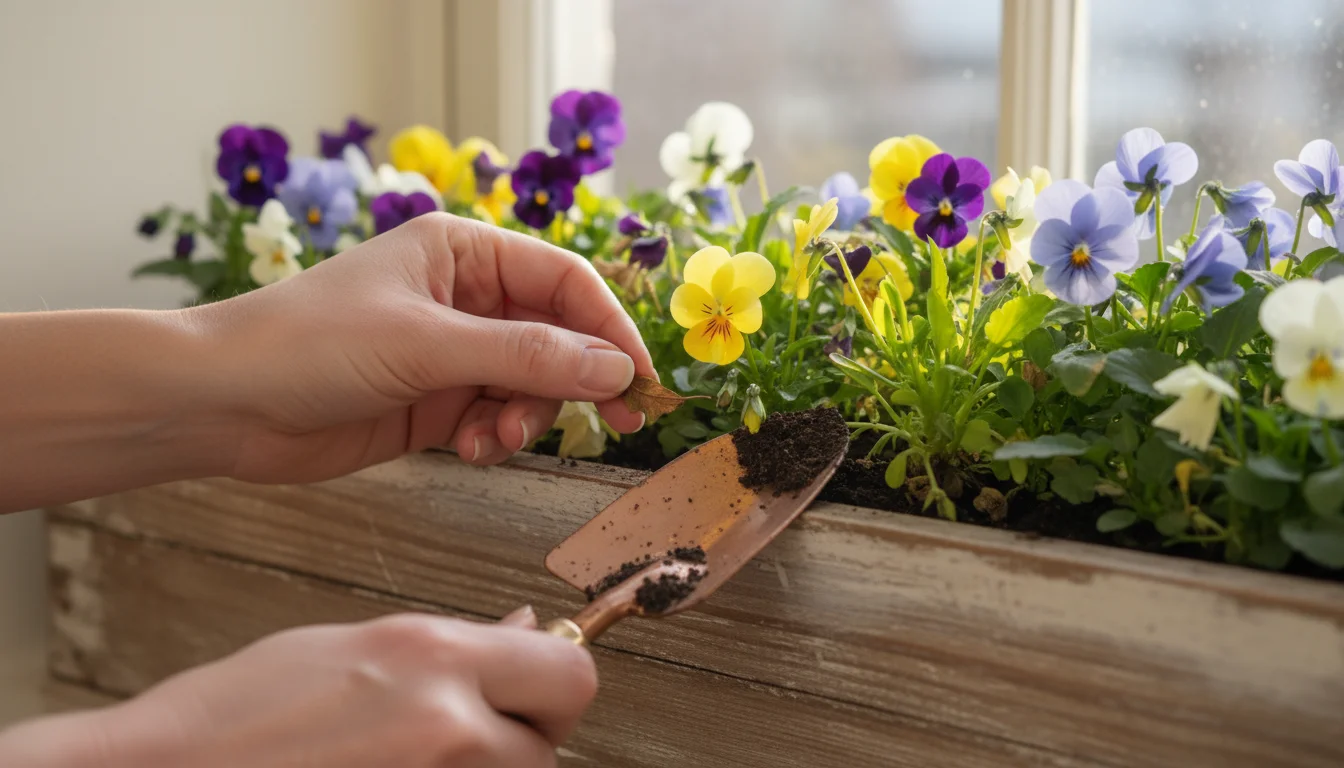
Wintering Over in Milder Climates
In USDA Zones 6 and warmer, pansies and violas often survive the winter and re-emerge to bloom again in early spring.
- Maintain Light Moisture: During dormancy, the plants still need a little moisture. Check the soil every few weeks and water lightly if it is completely dry. Avoid letting them sit in soggy soil.
- Persistent Protection: Continue to offer protection during any particularly harsh cold spells.
- Spring Revival: In late winter or early spring, as temperatures begin to rise, you will see new growth. This is the time to remove any dead or damaged foliage, refresh the mulch, and begin a light feeding schedule. Your window boxes will be among the first to offer cheerful blooms, often months before other annuals.

Succession Planting for Continuous Bloom
To ensure you always have fresh, vibrant edible flowers, consider succession planting. This means planting small batches of new pansy or viola plants every few weeks in early fall. For example, plant one window box in late August, another in late September, and a final one in mid-October. This staggered planting approach means that as older plants begin to wane, newer ones are just hitting their stride, giving you a continuous supply of what flowers can you eat that grow in fall.
By carefully adjusting your care based on the changing fall and winter weather, you extend the life of your beautiful and edible pansies and violas, ensuring your window boxes remain a source of joy and delicious garnishes for as long as possible.

Frequently Asked Questions
Here are answers to common questions about growing edible pansies and violas in window boxes.
Are pansies and violas truly edible, and do they taste good?
Yes, all true pansies (Viola tricolor) and violas (Viola cornuta) are safe to eat. They have a mild, slightly sweet, sometimes peppery or grassy flavor. Violas, particularly ‘Johnny Jump Ups’, tend to have a more distinct flavor. Their taste is subtle, making them versatile for culinary use without overpowering other flavors.
Can I grow edible pansies and violas from seed in my window boxes?
Absolutely. Starting pansies and violas from seed gives you more variety options and is cost-effective. Sow seeds indoors 8-12 weeks before your desired planting time in fall. They require cool temperatures (around 60-65°F or 15-18°C) to germinate. Once seedlings are strong enough, transplant them into your window boxes.
How do I make sure my pansies and violas are safe to eat?
Purchase plants specifically labeled “edible” or from reputable nurseries that use organic growing practices. If you buy from a conventional nursery, ask about their pesticide use. Avoid eating flowers from roadside areas or those treated with systemic pesticides, which are absorbed into the plant tissue. Growing your own ensures you control the inputs and maintain food safety.
My pansies are getting leggy and producing fewer flowers. What is wrong?
Legginess and reduced blooms typically indicate insufficient sunlight, too much nitrogen fertilizer (which promotes leafy growth over flowers), or a need for deadheading. Ensure your window box receives at least 4-6 hours of direct sun. Switch to a balanced fertilizer or one with higher phosphorus if you suspect too much nitrogen. Most importantly, regularly snip off spent flowers to encourage new bud development.
Can pansies and violas survive winter in my window boxes?
In USDA Zones 6 and warmer, pansies and violas often survive the winter in window boxes, especially with some protection like mulching the soil and placing the box against a warm wall. In colder zones, they might perish unless brought indoors to an unheated garage or shed during severe cold spells. You will often see them re-emerge and bloom again in early spring, sometimes even under a blanket of snow.
For research-based guidance on edible gardening, visit
University of New Hampshire Extension — Yard & Garden, University of Maine Cooperative Extension — Gardening, University of Rhode Island Cooperative Extension — Gardening and Connecticut Agricultural Experiment Station.
Disclaimer: This article is for informational purposes only and is not a substitute for professional advice. Consult local extension services for region-specific recommendations.
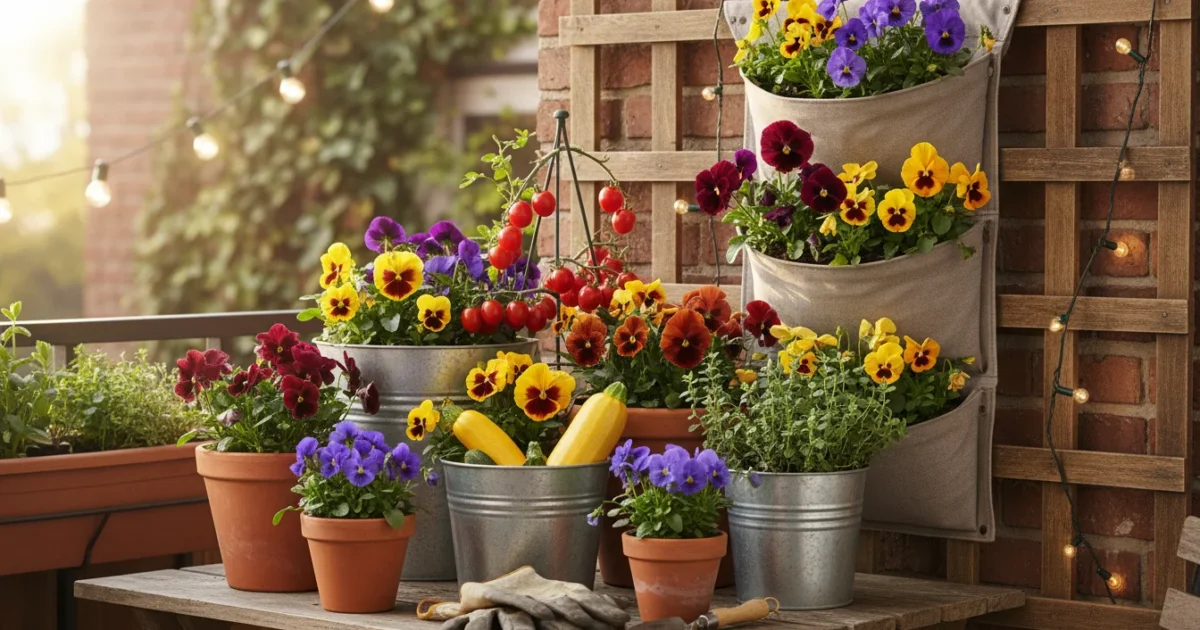
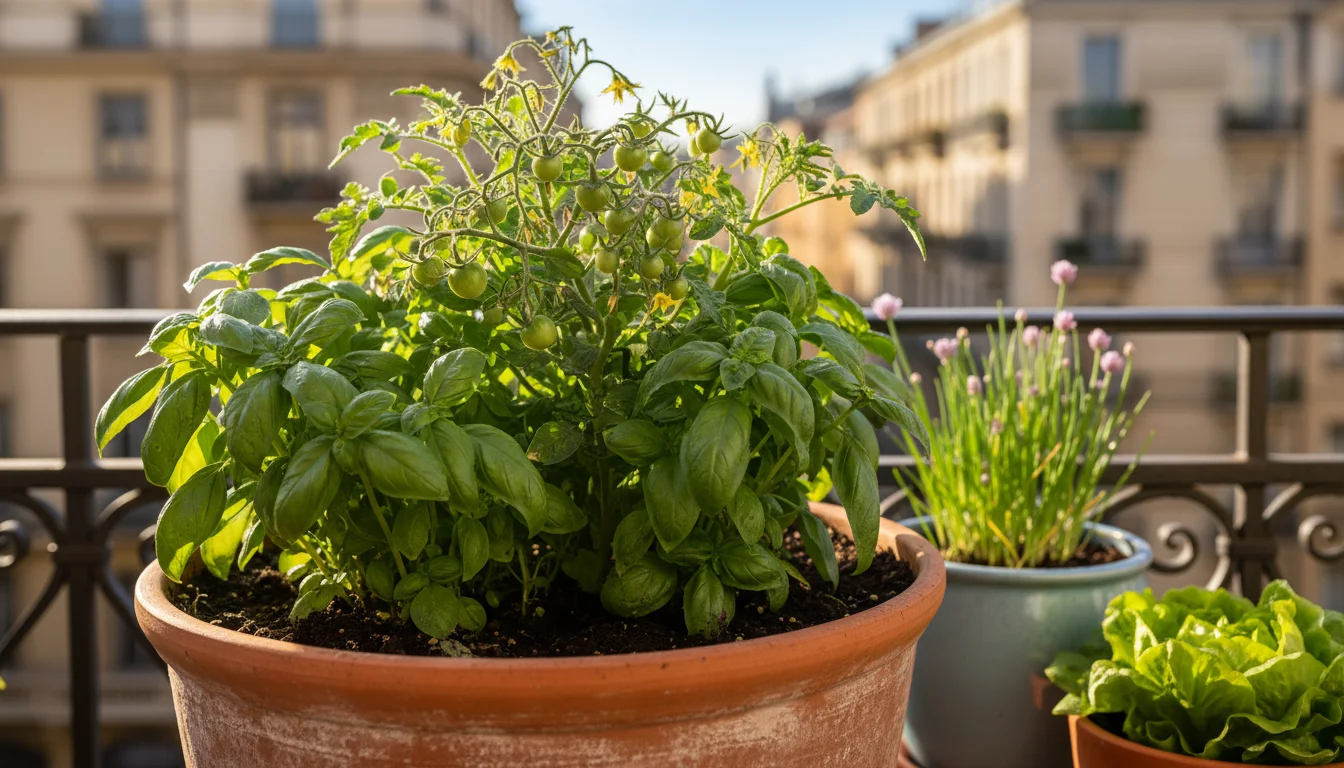
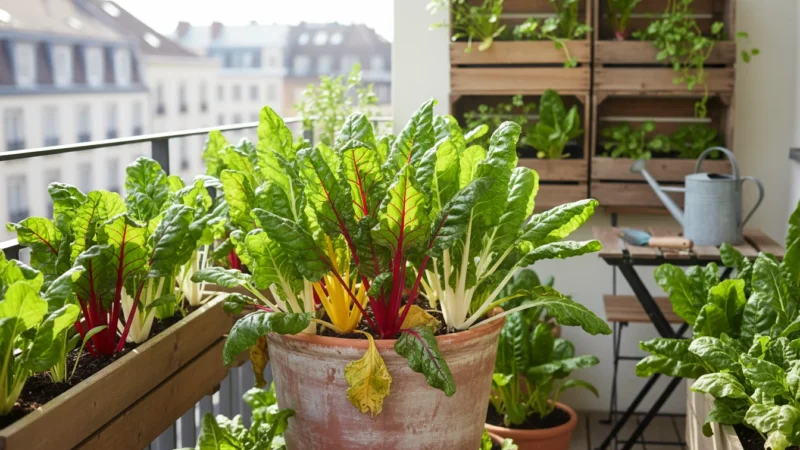

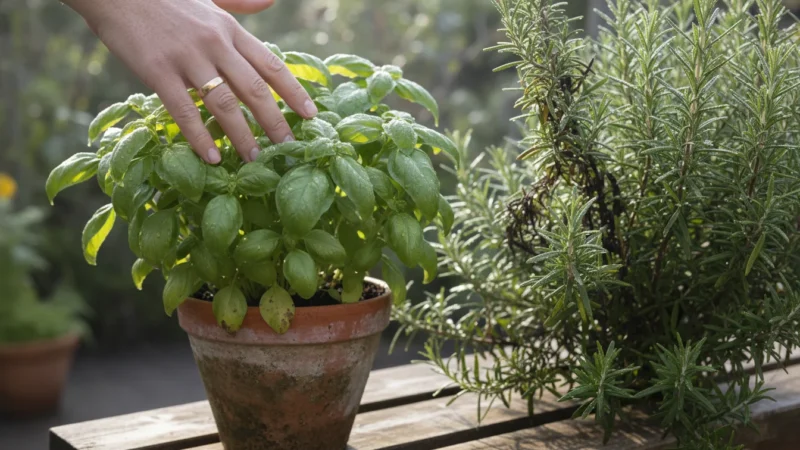
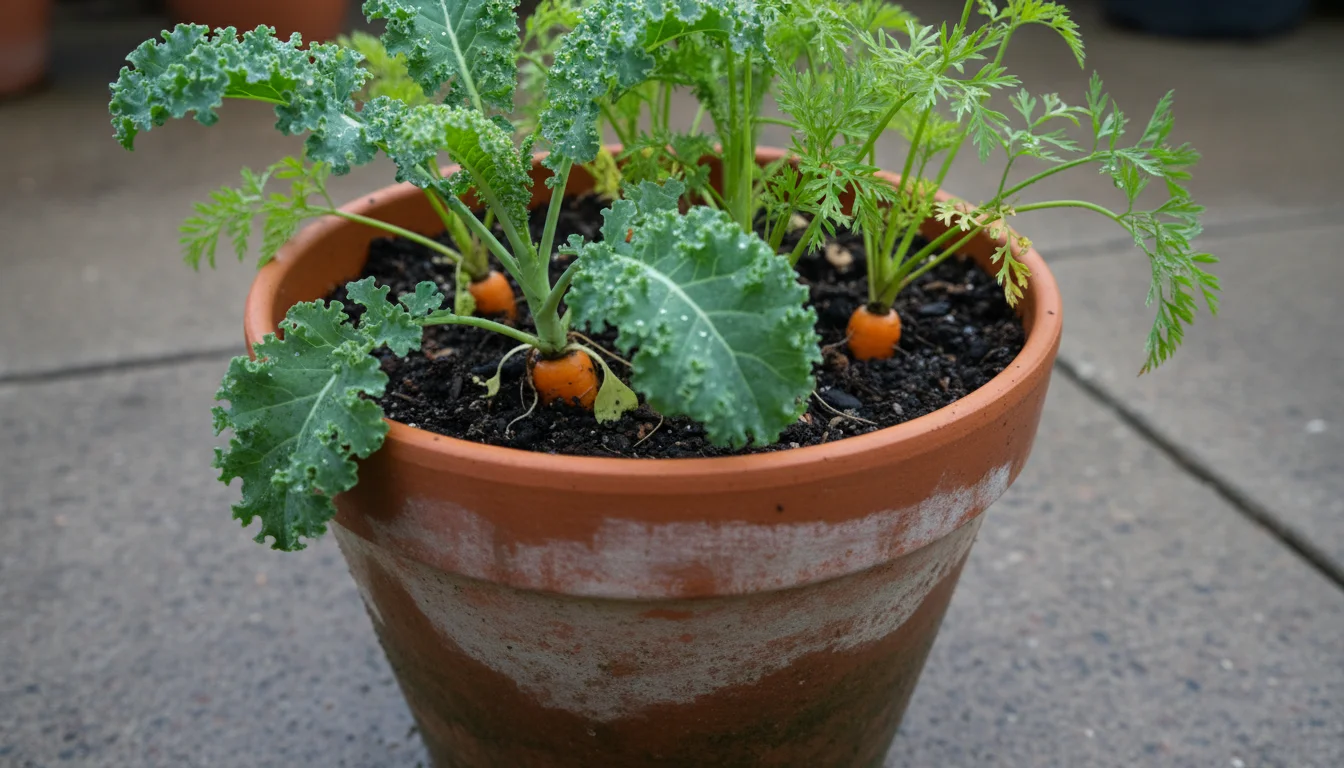
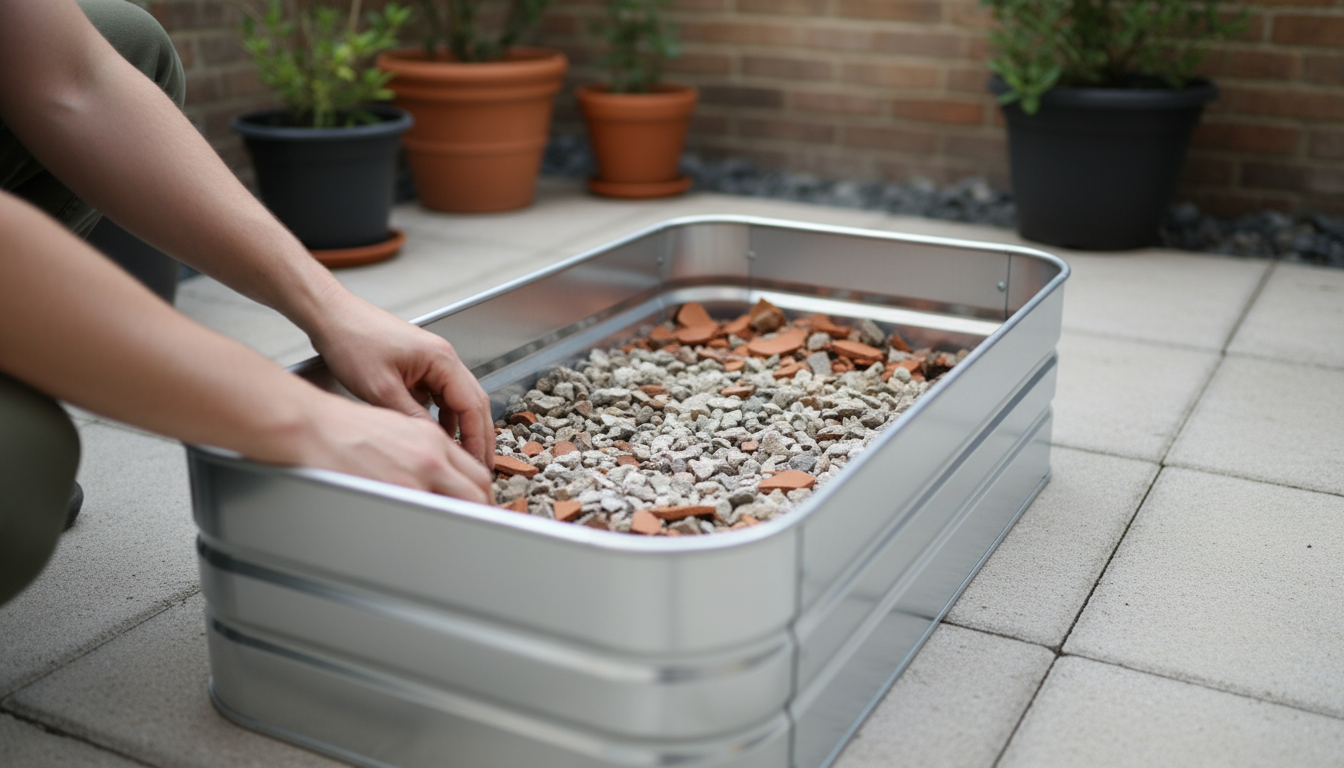



Leave a Reply